#quote is from official game guide ^_^
Explore tagged Tumblr posts
Text



WOLFHORN RANCH
"What was once a profitable Bighorner ranch has recently been abandoned, and its owner—a man named Ulysses—is nowhere to be found."
9 notes
·
View notes
Text
The Making Of: When I Win the World Ends
(For my previous Making Of post, see The Making Of: Cleveland Quixotic.)
I. 1999

It was the year of the cubicle movie. It was the year of Fight Club, of Office Space, of Being John Malkovich, of Three Kings, of The Matrix, and of American Beauty. It was the year of suburban malaise, of eternal sunshine, of ceaseless normality. A year of United States hegemony; a year whose chief terror was that THIS WAS IT.
Before the millennium turned and the towers fell, there was an initial challenge to this order, a completely inconsequential one made consequential by a newly minted 24/7 news media machine running out of noise to fill dead air now that people were sick to bursting of the Clinton impeachment. This challenge came not through war, revolution, or violence, but through entertainment. Children's entertainment.
And I was a child. Unaware of any cultural context, I knew only one thing: I loved Pokémon. I really, really loved Pokémon.
I owned Red Version, Blue Version, Yellow Version, Pokémon Pinball, Pokémon Stadium, Pokémon Snap, Hey You Pikachu, a Pokémon Tetris sort of puzzle game, even the Pokémon TCG game for Gameboy. I had ten to fifteen strategy guides for the games, an encyclopedia of the 151 Pokémon, a choose your own adventure book, an I Spy-style book. I had Pokémon figurines, Pokémon plushies, toy Poké Balls, toy Pokédexes. I had Pokémon stamps and Pokémon stickers and a deck of Pokémon cards. Not trading cards, just a standard 52-card deck with Pokémon pictures on it. Of course I also had the trading cards. A complete set of the first three runs, plus a special Mew card you could get from I dunno Toys R Us or something as part of some promotion. I had a guide for the card game that explained which cards were good or bad even though I didn't even play the card game. I had a Pokémon Tamagotchi and Pokémon pencils and Pokémon erasers and Ash Ketchum's hat and I dressed up as Ash Ketchum for Halloween. Of course I watched every episode of the anime, and in notebooks I drew doodles of existing Pokémon and came up with names for new Pokémon. My father had died that year.
My father was a sports fanatic. Traditional sports. He, too, collected. Sports memorabilia, baseball cards, figures of famous stars. When I was an infant, he drove me on a cross country road trip to Lambeau Field in Green Bay, Wisconsin, where I became a part owner of the Green Bay Packers. He had always wanted me to grow up and pursue professional sports. When I was born, the doctor apparently said to start looking for football colleges, a quote he saved in a scrapbook of baby photos. He had played sports himself, in college; he was a baseball catcher, until a hitter accidentally struck him in the head with a full force swing.
Almost everything I personally remember about him involves him dying. He was sick for a long time, and I remember hospitals and hospital beds and strange smells and gauze. And then one day my mother told me he died.
He was a charismatic man, very social and very popular. He had many friends and a lot of family, all of whom had constantly been around our house. Once he was gone, they stopped coming around. Then it was just me and my mother, who was not a fanatic for anything, except maybe her job as an elementary school teacher, which consumed her time as she assiduously prepared lesson plans and graded tests until late at night. When my father died, she got into some argument with his side of the family, the details of which I still don't fully understand, and afterward they no longer spoke. Her own family lived far away, out-of-state, seen only at Christmas. The house became quiet.
And I… played… Pokémon.
II. The Electric Tale of Pikachu

Toshihiro Ono was a mangaka primarily known for shotacon and futanari hentai. His credits such as Innyou Megami and Anal Justice made him a no-brainer pick for the officially licensed Pokémon manga, Electric Tale of Pikachu, as it too would feature a 10-year-old boy as the protagonist.
This manga would be the foundation for my conception of what Pokémon was, narratively. Though I also had the Pokémon Adventures manga that ran concurrently and which has by now long outlasted it, Electric Tale left a significantly deeper imprint on my memory.
In summary, Electric Tale is a retelling of the first two seasons of the anime. Ash Ketchum is the main character, he's accompanied by Misty and later Brock, his rival is Gary, and Team Rocket harangues him.
What sets Electric Tale apart is its tone, which is far more adult than Adventures and the anime. Obviously, part of this comes from the author's primary area of expertise being hentai. Even in the censored English version, there is a sense of sexual playfulness in how every single female character is an older woman who likes to tease Ash about his romantic interests.

But there are other elements that creep in unrelated to sex, due to the perspective of someone only used to speaking to adults who suddenly has to speak to children. Ono doesn't really get the childish fantasy of leaving at 10 being normal in society, so he introduces an element where Ash can only get a one year deferment from school and will have to return unless he hits it big. Team Rocket are former competitive hopefuls who flamed out and then, with no education or work experience to speak of, had no choice but to turn to crime. The Pokémon are depicted more realistically, often eschewing the toyetic mascot elements of their designs.

And the landscapes are often wistful, even apocalyptic in their presentation:

This more sedate, mature, realistic depiction of Pokémon became what I wanted Pokémon to be, what I projected onto an original Red and Blue version that left everything open to interpretation, and what would increasingly frustrate me with the series as it deviated more toward bombastic villain groups with goofy destroy-the-world plots. (Which was what put me off Pokémon Adventures.)
Amid all this, one panel stuck with me in particular. One panel I would think about ever since I first saw it as a child, that would turn around in my head and keep coming back. That panel would eventually—over two decades later—become the basis for When I Win the World Ends, the seed from which an entire story grew:
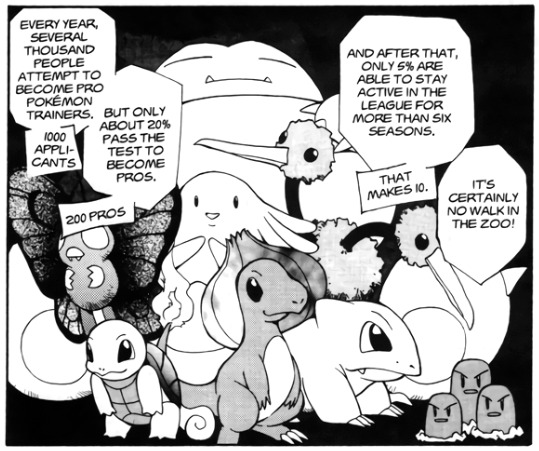
III. The Unkillable Demon King
But in the interim, the seed remained dormant. 1999 fell away. I grew up. I played later Pokémon games and increasingly lost interest by around Gen 4 and 5. Then I went to college.
That's when I started playing League of Legends.
I was something of a psychopath in college. I operated on a strict schedule and did not deviate. Wake up, read 50 pages of classic literature, write 2,000 words, go to classes, study, and then by about four in the afternoon all my obligations were done and it was League of Legends until midnight.
I wasn't actually interested in the League of Legends esports scene in its infancy. In 2012, I was actually invited to attend its World Championship in Los Angeles and refused. (When I received this invitation, I had just finished reading Homestuck for the first time, and was caught in a month-long haze in which I could do little but bask within what I considered the greatest artistic achievement I'd seen in my life. It was this month that inspired Modern Cannibals.) I only liked playing the game and watching Dunkey videos.
It wasn't until the next year, when a girl I was interested in recommended I watch, that I tuned in to my first professional League of Legends game, at the 2013 World Championship. It was there that I got to watch this new, hyped, upcoming Korean player who had apparently taken the pro scene by storm that season. That player was Faker.

It has seemingly become essential to the narrative of any sport that there is "the man who always wins." American football has Tom Brady, and the moment Brady retired, he was replaced by Patrick Mahomes. Basketball has LeBron James, picking up the mantle from Michael Jordan. It's as if someone being "the best" validates the skill-based promise of the sport, the fundamental top-down fairness of its premise, the idea that the person who wins is the best and deserved it. Faker would become the backbone of League of Legends esports and his ascendance correlated to that of the sport itself, from its humble roots at small-scale tournaments in places like Jönköping, Sweden, to max capacity arenas in the biggest cities in the world.
It's surprising, though, how the legend of Faker had already begun even before he won his first World Championship. League of Legends was designed as a clone of Defense of the Ancients (DotA), a popular mod for Warcraft III that emphasized competitive play. In its infancy, the competitive scene was mostly dominated by players who had migrated from DotA to League. They were older, winning thanks to a fundamental conceptual understanding of the game that was superior to everyone else, and frankly not very good in the aggregate. As League of Legends esports exploded in popularity from 2013 to 2015, these old pros would get filtered out swiftly, with even the biggest and most popular names retiring after only a couple of years in the scene.
Even once the new generation of League-grown talent ascended, though, careers were nasty, brutish, and short. The best players only remained on top for a season, as game patches dramatically changed viable strategies. Internationally the sport was dominated by Koreans, with the Korean regional league sometimes being seen as more difficult to win than the World Championship, where Koreans often breezed through uncompetitive Chinese, European, and North American squads.
This possibly affected the demographics of the professional scene. South Korea has mandatory military service, and leaving the pro scene to join the military was basically the end of a Korean player's career. This meant that it was rare to see a Korean player older than 25. Retiring in your early 20s was and remains common. Korean organizations, which had an infrastructural leg up on other regions due to the popularity of StarCraft 2 esports in the country, became adept at scouting promising players at 15 or 16, building them into top level competitive pros, wringing them dry for a few seasons with brutal training regimens, and spitting them out.
Faker was the exception. Though he had been discovered young by SK Telecom, a major Korean telecommunications company that did esports on the side, and gone through the training regimen, he refused to be spit out. He simply didn't stop. He won in 2013, then with a completely new four-man squad around him won again in 2015 and 2016 before narrowly losing the 2017 finals in a nail biter. Given League of Legends esports had only existed since 2011, he basically accounted for half of the championships up until that point. Nobody else, except for his teammates, had won more than once. And it was like it was known he would be this juggernaut the instant he manifested ex nihilo. Like it was known, even in 2013, that he would always win.
Then, Faker stopped winning.
By 2017, League of Legends esports was a titan. Venture capital firms, seeing the millions of eyeballs, thought that this was the next NBA in its infancy, and decided to get in on the ground floor. Multiple millions of dollars were pumped into the scene as even mediocre players in weak regions like North America pulled seven-digit salaries. In China, where League of Legends had become the national pastime, the nation's richest oligarchs ran teams for fun and vanity, outbidding Korean organizations for top Korean players in pursuit of a trophy that had gone to Korea every year since 2013. Riot, the studio developing the game, pumped tons of money into creating a professional sports product, with skilled announcers, dedicated arenas for regional leagues, live performances by musicians like Imagine Dragons and Lil Nas X, and all the other bells and whistles one might expect from a program watched on ESPN.
In this milieu, it seemed like Faker had finally reached his limit. He was still good, but not the best. Even as an individual, while everyone still considered him the "greatest of all time," he was considered outmatched by newer pros like Chovy and ShowMaker. 2018, 2019, 2020, and 2021 passed with no championships. In 2022, on a team of mostly rookies, he reached the world finals, but was ultimately beaten. Korea's stranglehold over the sport had been shaken by China, which had finally strung together some championships. People wondered if Faker would retire, although he had managed to avoid mandatory military service by representing Korea in the Olympics-esque Asian Games. He'd dealt with wrist injuries and his level of play dropped year over year. He just didn't seem to be that good anymore, potentially holding back his team of talented young players rather than leading them to victory.
Then, in 2023—
youtube
And in 2024—
youtube
In the end, never count out Touchdown Tom. 11 years of professional play, 5 world championships.
From this longwinded explanation, you might have realized that after watching that game in 2013, I became a League of Legends esports fanatic, fulfilling the prophecy set before me by my father though perhaps in not the way he would have expected.
And the things I become a fanatic about, I want to write a story about.
IV. Modern Cannibals
There's a deleted scene in Modern Cannibals, as Maximillion is driving Z. and her friends through the Utah desert. He starts to talk about Pokémon.
"I bring it up because my university thesis was about Pokemon in particular how Pokemon has basically trained an entire generation of children to think in a completely different way than preceding generations my generation for instance our fad was Teenage Mutant Ninja Turtles now I don't know how much you know about Teenage Mutant Ninja Turtles but from an educational standpoint we're talking absolute bankrupt complete and utter goose egg but Pokemon now Pokemon you see it's more like there's some substance to it you know that refrain Gotta Catch Em All right?" "..." "Well to most parents it looks like a marketing gimmick you make one hundred fifty-one characters and structure a game around collecting them the merchandising potential is astronomical kids buy one hundred fifty-one trading cards stickers coloring books figurines uh collectable lunchable toys I'm sure you've got some yourself."
He continues:
"But really you look at the game itself before the big toy explosion the game itself the focus is placed less on the collection and more on the catalogue you're given a blank encyclopedia to fill and you fill it by capturing one hundred fifty-one Pokemon but the goal is to create a complete database of each and every one and this is what I argue is the educational core of the Pokemon series." His hands left the wheel to conceive of his idea in the cool air of the car, which remained steady on its ever-forward path. "Our modern era is no longer one of singular isolated knowledge it is one of the catalogue the database which is most clearly personified in the advent of the internet because now all knowledge can be at the fingertips of any one human being all that is needed is someone to go and put the catalogue together and presto whiz bang it's there think about it Z. when you catch a bunch of Pokemon where do you store them?" Z. didn't need to think long to remember the game's mechanics. "In the PC." "Exactly now isn't that odd consider it in real life terms you have real life creatures made assumedly of flesh and bone and yet you store them in a computer how does that make sense you'd expect a farm or a holding pen but no it's the computer and that too prepares the budding portion of the millennial generation to become cognizant of the linkage between the computer the encyclopedia and the database structure of knowledge in a new era." "So," said Z. "So you're saying Pokemon taught kids how to think in the digital age?"
There's also a deleted character in Modern Cannibals. Well, mostly deleted—he still shows up, unnamed, in a couple of pages. He is Cole Coulter, Z.'s older brother, a popular League of Legends streamer. Before I deleted him, his role was to accompany Mrs. Roddlevan and Frederick in an attempt to bring Z. back home. He had POV scenes that gave insight into the weirdness of his cotravelers, but ultimately, I decided he didn't add anything to the story and removed him almost entirely.
Even then, though, I was already considering the future of Cole Coulter as the protagonist of a story about League of Legends esports. Playing under the ID MadKing, he would be a North American professional top laner, once known for his aggressive duelist style but recently forced into playing boring tanks as the esports metagame became more sophisticated and tactics-based.
The story would be simple, something I envisioned as a "sports story" only about esports instead of regular sports. It would start with Cole's team being relegated from the league, only for Cole to get a last chance signing to a new team with two promising Korean imports. One import, the mid laner, would be a charismatic and eccentric player in the mold of Doinb/Ganked By Mom/Huhi, while the other, an AD carry, would be introverted and pissy and elitist, in the mold of Piglet. The team would initially struggle, cultures would clash, then a mid-season replacement to sign a psychopathic Tyler1/Tarzaned style streamer as jungler would revitalize the team, put them on a major run, and get them to the World Championship. Though they would eventually fall after a miracle run, Cole would get a moment to truly shine on the biggest stage when he won a pivotal game by aggressive split pushing rather than tank play.
Thematically, the story would be about two things. First, a counterpoint to the idea of American exceptionalism, featuring a league where Americans are particularly bad compared to Korean or Chinese players. Second, an exploration of what it means to be exceptional at all. Cole would be an all-around mediocre person. Middling at school, at (real) sports, at the various popularity contests of being a teenager. League of Legends, this niche sub-sport, is the one thing he truly excelled at, the one place where he was good, better than 99.9 percent of all players, and yet even within that statistical greatness he wound up, ultimately, in a professional scene where he was once again mediocre, relegated to "tank duty," to facilitating other players to carry.
What does it mean to be the best? How can someone be so, so good, only to reach a level where they were still nothing special? Is there any way to win if you're not "the man who always wins"?
I remembered that panel from Electric Tale of Pikachu. The last people filtered before the final champion. It's certainly no walk in the zoo!
This idea was pretty detailed for a story I never wound up writing, something I mostly blame on the years 2018 and 2019, when a lot of bad things happened to me and in retrospect I consider it a minor miracle I managed to finish Chicago at all. As a human being, I would be decimated for the next three years, and so a lot of stories I might have written in that time never came to fruition.
Meanwhile, League of Legends esports reached a peak, then the venture capital bubble burst as investors realized there was no monetization scheme in place for any interested party except Riot Games. Money hemorrhaged out, Riot shifted resources to Valorant, and a sport that had been overinflated based on projected exponential growth in perpetuity fell back down to earth.
Also, Players came out.

Players was a 2022 mockumentary about a fictional League of Legends team competing in the North American league. Conceptually, it was doing a lot of what I had planned for my story: following a single team on a rags-to-riches run, focusing on the interpersonal drama of the team members, asking questions about greatness and its pursuit. It's a pretty good show if you're familiar with League of Legends esports at all, with a lot of on-the-ground fidelity that gives it an authentic feel, which is exactly what I had been hoping to use my esports fanaticism to accomplish. It completely took the wind out of my sails; it was like my idea had already been done.
So by 2022, the idea of a League of Legends esports story was dead. But there was still a drive to create something with that spirit, that would delve into those themes.
What remained after all these years of sifting the sieve, letting sand slip through, was that one panel from the manga. The number of people pursuing greatness slowly filtering until only one remained. And if I wasn't going to pursue that idea through League of Legends, maybe I could pursue it through another vehicle. Maybe the vehicle through which the idea had originally been exposed to me. Pokémon. It all came back to Pokémon.
V. Everything Evolving Into Crabs
I knew immediately that if I were to write a Pokémon fic, it would be a tournament arc. This was the natural evolution of my esports story idea. Also, if I were to write Pokémon, I wanted it to be a story about utopia, immersed within Pokémon's near-future ideal world, where everything is clean and healthy, where society is neat and ordered.
This idea caused me to remember the novel Eyeless in Gaza by Aldous Huxley, which I had read a few years back. A mostly autobiographical bildungsroman written on the precipice of World War II, the novel ends with the young protagonist on a journey to Central America, where he meets an idealistic doctor who believes sport to be a proper substitution for war. He tells the story of two tribes locked in internecine conflict through generations, able to replace that violence with soccer matches.
And wasn't that what the world of Pokémon was, a utopia revolving around neutralizing weapons of war by using them for competitive sport?
This tournament, I envisioned, would not simply be about deciding who was best, but an ideological battle for the future of the Pokémon world. To that end, I imagined a war between an entrenched trainer class, who competed as philosopher-warriors, intense individuals with deep connections to their Pokémon, and an upstart commercialization that sought to replace the ideological underpinnings that made their society so safe and prosperous with economic accumulation. It was from this kernel that the character who would become Aracely Sosa arose: charismatic, appealing, human-empathic, and propped up by a support staff who did all the hard work of teambuilding for her.
I imagined the story having an ensemble cast, focusing on nearly every competitor equally, with the Aracely character not having any especial focus until her improbable rise to the top. I imagined a final round where she faced off against "the man who always wins," and though she would lose to him, she would seem to have won the ideological battle, altering the course of society as major corporations scrambled to employ her formula for success at a much grander scale. The story would end with this realization of the earth-shattering importance behind her run, only for Aracely to sink in disappointment. Because in the end, all she really wanted was to win.
The more I thought about it, though, the less I liked the idea of an ensemble cast. The ensemble cast element of Chicago hadn't gone over very well (though I like it), and I figured it would wind up inflating the length of the story considerably. I was coming to the end of Cleveland Quixotic, after all, and once more wanted to write something smaller, tighter, and denser.
So I oriented my thinking to instead have the story revolve around Aracely and one major rival, to give an interpersonal mirror to the ideological war being waged. Thus, Toril came about as an antithesis to everything I had imagined Aracely to be: gruff, antisocial, independent. Their rivalry would culminate in a semifinals battle, before Aracely went on to fight "the man who always wins" in the finals.
I forget exactly when the gender theme came into the equation, but it evolved as an outgrowth of (once again) my competitive League of Legends expertise, where women are essentially nonexistent despite there seemingly being no biological blocks against them. This dovetailed nicely with Pokémon, a world where women seemingly could be powerful competitors, but where—in the anime at least—none ever are. For instance, look at this chart of every major tournament in the anime:

Every known winner is male. Every known finalist and semifinalist is male. Only a handful of female characters have reached the quarterfinals. What possible in-universe justification could there be for that?
This question was actually far more prominent in early planning and drafting than it wound up being in the final work. Initially, I had Aracely's personal motivation revolve around a drive to be the first female trainer to win; this would increase the ideological conflict between her and Toril, who attempted to ignore that she was female altogether. Over time, this theme would see diminished importance in face of the last piece of the thematic puzzle: cults.
It came from reading Underground by Haruki Murakami, a nonfiction journalistic account of the 1995 Tokyo sarin gas attacks carried out by the cult Aum Shinrikyo under the direction of its leader Shoko Asahara. Japan in the 90s was experiencing its own End of History, one taken literally by those disaffected with modern society's grand narrative. The prophecies of Nostradamus became fashionable among the young, who believed that 1999 would be the final year before the world was destroyed. Murakami interviewed both survivors of the gas attack and members of Aum Shinrikyo, collecting worldviews of people who simply thought they were "different" and who were willing to give everything in their lives to the one place that seemed to accept that difference.
The 1995 attacks were a watershed moment in Japanese culture. In their wake would come pivotal works of Japanese pop media, like the titan of otaku culture, Neon Genesis Evangelion:
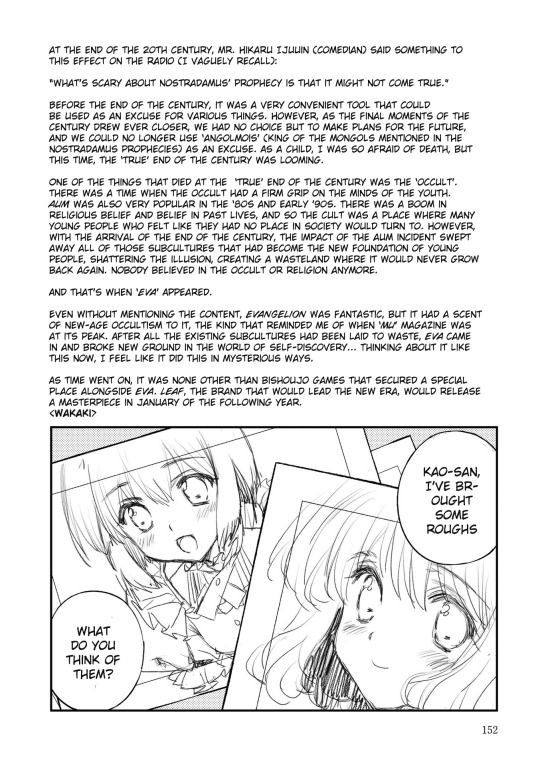
(What's scary about Nostradamus' prophecy is that it might not come true. A year whose chief terror was that THIS WAS IT.)
Pokémon, whose first games released in Japan in 1996, also emerged within this post-Aum world where fixation on the minutiae of pop media was becoming a primary pillar of meaning for the youth, and it's hard not to see echoes of cultism in the evil teams that dot the series' landscape. Even Team Rocket, originally more modeled on organized crime than occultism, veers that direction in Gold and Silver, and afterward the organizations and their world-ending plots become increasingly absurd, to the point where it starts to become unclear why anyone would ever follow, say, Lysandre.
As I mentioned earlier, my personal interest in Pokémon was at odds with these clownish, Saturday morning cartoon villain organizations, but Murakami's account of the Aum attacks recontextualized them for me, made them make sense even within the framework of a "realistic" utopian world. The last elements snapped into place, and I knew my main character would be the member of one of these cults. A cult dedicated to, what else? Evolution. A core element of the Pokémon series, a perfect metaphor for the frustrating lack of movement of the End of History 90s. I imagined a cult leader as a surrogate mother figure for Aracely, who would have a strained relationship with both of her own parents, and deciding on that, the idea of making Pokémon's canon evil mother Lusamine the villain was a no-brainer. I imagined a post-SuMo Lusamine, unable to move on from her experience merged with Nihilego, languishing in Kanto after being sent there to consult with Bill, who had his own experience being merged with a Pokémon... It didn't take long to figure out how all these pieces connected.
The full form of the story had taken shape.
VI. Showdown
I knew immediately I would be following Showdown rules for the battles. No alternative even crossed my mind. I had dabbled in Showdown a few times over the years, first in Gen 3 OUs, then later in Gen 7 OUs, and I knew from experience that Pokémon is a monumentally more interesting competitive game when operating at a high level compared to either its depiction in the anime (shounen logic, mid-fight evolutions) or the general playing experience (spam your best move on your overleveled starter). I knew I would use competitive rulesets before I even considered the thematic or worldbuilding aspect I would eventually take in the story itself (i.e., that the specific rulesets prevent battles from becoming bloodsport and enforce order on the world). I simply thought doing battles this way would be far more entertaining.
To prepare, I started playing Gen 9 OUs under the guidance of a few friends who were into the competitive scene. I grinded the ladder for months, eventually getting a good enough grasp on the metagame to reach 1500 Elo on the Showdown ladder, which is not very good but generally higher than someone can reach with dumb luck.
Crafting the tournament format and rulesets used in the story wasn't difficult. I modeled the tournament format on the League of Legends World Championship, with region-based seeds (having been selected due to performance in regional tournaments) competing in four groups before the highest performers advanced to a single elimination bracket. Initially, I envisioned a 32-competitor bracket instead of the 16-competitor bracket that would appear in the final draft, but otherwise the format came quickly and easily.
In terms of the rulesets and available Pokémon, my considerations were made primarily in terms of what would be most entertaining to read. I decided to include Mega Evolutions and not include Z Moves, Dynamax, or Terastallization, because Mega Evolutions are cool and those other gimmicks are not. The bring-9-pick-6 format, while unusual in Showdown rulesets, is similar to the rules in Pokémon Stadium and VGC tournaments, and also adds a level of intrigue to which Pokémon each competitor uses. (It also enabled Red's Zapdos at the climax of the story, which was something I knew I would bring out from very early on.)
With the help of one of my friends who knew competitive Pokémon, I scripted out each battle assiduously before I wrote them. Every battle was tested using Showdown itself, with only a few turns mocked up to account for luck. For instance, in Aracely versus Jinjiao, Slowking is meant to stay asleep for three turns. Rather than rely on luck to ensure Slowking actually slept that long during the test, I could give Slowking a useless move and have him use that instead to simulate being asleep.
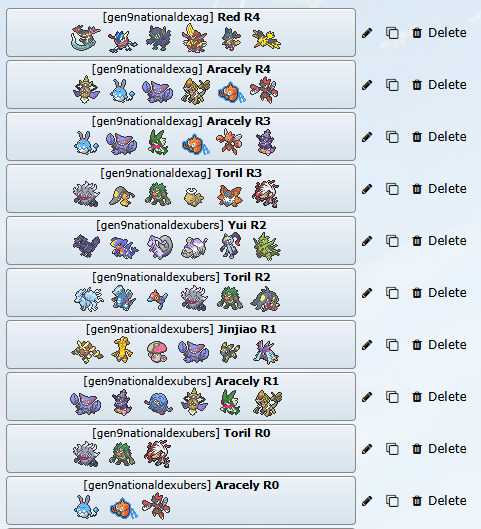
The only thing that couldn't be tested in Showdown was the 7 PP Kingambit trick Red uses at the end of the story, because it's impossible to set a Pokémon to have fewer than max PP in Showdown. This led to one of the bigger mistakes of the story, as it turns out that Encore would simply wear off if Kingambit ran out of PP, rather than forcing him to use Struggle like I assumed. Luckily, even if this were the case, it wouldn't change the outcome of the battle, so it's not an error I lose too much sleep over.
Character teams were chosen to thread the needle between a few considerations. The team needed to be competitively viable, reflect the character's personality in some way, and be distinct from other teams for the sake of variety. (Variety is somewhat unrealistic in real top-level competitive Pokémon, where you'll often see many almost identical teams in the top ranks. But that would be boring.) Some lack of optimization was allowed under the conceit that actually training these Pokémon to peak form would take a lot of time in the real world, compared to Showdown were optimization can be determined quickly due to the ability to immediately adjust stats and builds.
I also tried to give some preference for Pokémon that would be more familiar to layman fans, though this was difficult because Gen 8 and 9 have outrageous power creep and many popular early generation Pokémon have been completely phased out. (Using Megas helped with this issue.) It was this consideration that led to Azumarill being Aracely's ace. There was also an innate challenge to imagining what the competitive scene would look like without legendary Pokémon. Zapdos and Landorus-Therian have been inexorable staples of the competitive scene for generations. What happens in a world where they aren't used at all?
In the original 32-person bracket, I imagined Aracely competing against Jinjiao in the first round, then minor characters Adrian da Cunha and Jacq Ray Johnson in the next two rounds, before facing Toril in semifinals. I imagined Adrian da Cunha as a "hometown hero" whose team wasn't great but he was plucky with a lot of grit, and Jacq Ray Johnson as a self-aware heel who liked to use cheesy strategies and gimmicky Pokémon like Smeargle and Ditto. Condensing from 32 to 16 occurred around the same time I had settled on Lusamine as my villain/cult leader, which led to replacing those two with Gladion. I developed full brackets for both the 32-man and 16-man iterations, with character names and regions, just in case I ever needed to mention them.
All that was left to do was write the story.
VII. Unbroken Line of History
I began writing in September 2023 under the tentative title Unbroken Line of History, which I would later change to simply Lines. In the original drafts, I opened the story with a modified version of the panel from Electric Tale of Pikachu detailing how people are filtered over time in their pursuit of being the best, this time starting with all 8 billion people in the world until only one remains. The story then cut to Aracely's perspective in the restroom as she mentally prepared for her final group stage match.
At this point I was more set on Aracely being the clear protagonist of the story, so she had a few facets of her personality designed around that. First, as I mentioned before, there was a feminist angle where she was motivated specifically to be the first female trainer to win the championship. Secondly, I threw in some more generic nervousness/fear of failure. The other major difference is that I did not lead with the cult prophecy of the world ending. I originally envisioned the cult reveal to be a mid-story twist, and only obliquely hinted at it.
The scene still played out with Toril appearing and the two getting off to a bad start. Then, Cely's father tried to talk strategy with her while she ignored him, before the battle transpired in much the same form as it does in the final draft.
I showed this early draft to my friends and most disliked it. My girlfriend at the time told me Cely sounded like an edgy 13-year-old boy, while my neuroscientist friend whose aspirational idol is Bondrewd from Made in Abyss wanted to know more about the oblique hints of a cult, finding everything else boring. Another friend said it was stupid that there were 30 seconds between turns during the battle and that the Pokémon should just go at each other; nobody would actually want to watch a battle that was paced so slowly. (I vehemently disagreed with that take. Basically every popular sport balances between slow-paced moments of strategy and fast-paced moments of action and execution.) Some people I showed it to did enjoy it, though. Gazemaize, the author of Chili and the Chocolate Factory, was especially enamored by the Brittany/Gardevoir reveal and the Bud Light Analyst Desk, and implored me to keep both of those elements at all costs. 7th, one of my friends who helped me with the Showdown stuff, was so into it she drew fan art of all the characters (which I've posted before) and also wrote eight pornographic short stories about them.
I rewrote the same opening scene several times across October and November, though these were minor iterations without significant adjustments. Frustrated with the lack of progress, I decided to take a break from writing to simply think about the story for a few months.
During this time, to fix Aracely's edgy 13-year-old voice, I decided to lean into her being from Pokémon Los Angeles (with her native region, Visia, being a play on "visual" as a reference to Hollywood) and gave her a Valley Girl accent. To prepare for this, I listened to hours and hours of ASMR videos of people speaking like Valley Girls and took notes on their inflection and syntax. It was here where I decided on Aracely's underlining quirk, as a way of capturing the unique style of emphasis Valley Girls used.
This also made me realize I needed to adjust Aracely's personality. Despite the tone of her voice, she was still acting antisocially. She didn't want to talk to her father, she didn't want to talk to Lachlan Nguyen, she didn't even really want to talk to Toril. Toril herself was a lump of coal. My own misanthropy kept leaking into the characters, even when I conceptually didn't want them to have it. I thought back to Cleveland Quixotic, and how what made the Jay and Viviendre romance work was that they actually both liked each other, and figured—even though I didn't have explicitly romantic plans for Aracely and Toril—that I needed to do something similar to make their rivalry truly pop. Rather than avoid people, Aracely would lean into talking to them, even if they were annoying. Although Toril remained frigid, there would be a part of her yearning for emotional contact, a way to coax her out of her shell.
I also thought deeply about the structure of my stories in general, and my inability to come up with good hooks. It was around this time that someone I knew was reading Chicago. They pointed out that the plot of Chicago doesn't really start until Chapter 26; that I was "burying the lede." I considered this. My logic, when writing Chicago, was that the Empire moving to take over Washington would be a twist, something that would shock and excite people and change their perception of the entire story.
But did that make sense, when really the story was "about" that twist? Didn't that just make everything before the twist harder to get into for a reader? Chicago might look radically different if I revealed the Empire's goals immediately, but it would also probably be a more immediately engaging work. I'm a big fan of delayed gratification in storytelling, but had I taken it too far?
This was a major revelation for me, and immediately I understood what I needed to do for my Pokémon story: move up the cult plotline. Place it front and center. Name the whole story after it even. I decided on framing the opening scene from Toril's perspective, depicting Aracely initially more as an alien other, emphasizing the fact that she was in a cult rather than hide it behind foreshadowing. This could also lead to Aracely and Toril having more of a dual protagonist setup, which would make my planned two-half finale (one half where Aracely battled "the man who always wins," one half where Toril got involved in stopping the cult's doomsday plot) work even better.
Confidence resurged. At the end of January 2024, my girlfriend of seven years and I broke up. A few days later, I started writing the sixth—and ultimately final—draft of When I Win the World Ends.
VIII. When I Win the World Ends
Now it's the part of the Making Of where I actually make the thing I'm supposed to be making, but there's a lot less to say about it. Once I have a plan, the actual writing of the story is the easy part, and most of what I wrote—with a few exceptions—looks similar to the story as it exists now.
There were some oddities. I wrote the first seven chapters (everything up to the end of the Jinjiao battle) and then had to take a two week break to write a short piece for a writing contest I had entered in December as part of an effort to stop overthinking WIW. After this interruption, I returned to WIW writing perhaps a bit more perfunctorily than I usually would, leading to an original version of Chapter 8 (the chapter where MOTHER makes her first real appearance) that was short and abbreviated. Later, in editing, I would rewrite most of this chapter.
A few ideas emerged while writing, like the motif of serendipity/Logos, which I felt tied nicely to the ideas of evolution and history. It was also in this draft that I introduced Cely's friends Haydn and Charlie, as a nod to an earlier work of mine also featuring a fashion-obsessed girl from Los Angeles. (Speaking of nods to earlier works, in the original 32-man bracket, Cole Coulter featured as one of the competitors, but he didn't make the 16-man cut.)
The process went smoothly. I finished the draft at the end of May, a little under four months after I started it. I had envisioned the full story as being about 70,000 words, but the draft ended up closer to 115,000. Underestimating story length is just an essential element of the trade, though.
A few days after finishing the draft I went on a four-day Oklahoma Darkness Retreat where I had access to zero electronics. The goal was to think about my story deeply and how it could be improved in the editing process.
In this time chamber, where I did nothing except complete crossword puzzles and read The Recognitions by William Gaddis, I came to a realization. There was one element the story needed that wasn't already there.
That element was Sabrina. In the original draft, Sabrina was not present during the scene where Aracely meets the Old Man. She was mentioned obliquely a couple of times in conjunction with Aracely's "psychic powers," but it never really built to anything. There was still a scene where Aracely was interrogated due to her relationship with MOTHER, but only by nameless goons, and the scene lacked tension as it was clear Aracely could talk circles around them.
When I returned from Oklahoma, I prepared for my conception of Sabrina as a character by writing an 8,000 word short story from her perspective, which hashed out an entire backstory for her. Then, I started editing the draft.
For me, a lot of editing is just polish. Usually, cutting out needless sentences and fixing clunky ones, as well as emphasizing a few of the more understated themes and motifs. For instance, during editing, I made slight additions to emphasize the thematic connection between Aracely's suicide attempt and the global war that almost destroyed the world, as well as the connection between the moon and cyclical insanity (lunacy, etymologically, being related to the moon). I made the Old Man more of a Walt Disney-esque figure (from my notes: "a dying Disney"), rewriting much of his dialogue to either be direct quotes or to evoke his ideals. I also expanded on several of the scenes where Toril and Aracely interact to make their relationship more complex and nuanced. I gave MOTHER some new dialogue, including her speech in Chapter 18 about loving a child for the potential it promises, while also paradoxically wanting it to remain a child forever.
The largest changes were in the three chapters I almost fully rewrote. The first was Chapter 8, which as I mentioned earlier was overly terse. In the original draft, it depicted MOTHER as more pathetic, more dependent on Aracely. I decided to make her a more threatening figure, and incorporated a few references to the Moloch sacrifice scene from Valle Verde to make her seem more like a false idol. Similarly, I rewrote Chapter 12, which was originally a very short chapter that focused solely on a conversation between MOTHER and Nilufer that ended with the order to kidnap Aracely. In rewriting the chapter to include Fiorella, I gave myself more opportunity to flesh out the respective philosophies of her and MOTHER (including some of the story's most salient discussions about why cults exist), as well as give more of an insight into the inner workings of RISE as an organization. And lastly, I fully rewrote Chapter 19 to include Sabrina.
The last changes I made in editing were to the final chapter. When I finished the final draft of the story, I sent it to several readers, many of whom had looked at the original drafts of the first chapter, as well as julirites, the author of a Fargo fan fiction called London. There was an immediate and minor backlash to the final chapter, which was originally much more pessimistic, from most people who read it. In the original version, Aracely and Toril were not still in communication. (Fiorella was also dying of cancer instead of jockeying to replace the Old Man.) The finale had a much more somber, sedate, tragic note. Juli and 7th disliked this sad ending, while Gazemaize wanted me to cut the final chapter altogether. I felt confident that the final chapter was necessary, though, and revised it to its current version, which was much better liked.
And then... the story was finished, near the end of July. I crunched the numbers and realized that if I posted two chapters to start and then did a twice-weekly posting schedule, I could end the story serendipitously on October 12. So I did.
IX. Names and Special Thanks
In my Making Of post for Cleveland Quixotic, I had a fairly extensive list of where I got all the character and place names from. The list is a lot less extensive here; most names I constructed for the purpose of sounding evocative, rather than taking them from someplace specific. For instance, I chose the name Aracely Sosa because it sounds like whistling with its repeated S sounds, compared to Toril Lund which is a lot harsher with its consonants. You can see a similar rationale behind names like Fiorella Fiorina, Yui Matsui, and even some of the background characters, like Jacq Ray Johnson, Jr., where there is a lot of emphasis on alliteration and rhyme.
There are a couple of exceptions. Jinjiao is the in-game ID of a longtime Chinese League of Legends pro of middling notability. He picked the name (which means "Golden Horn") as a reference to the Golden Horned King, a villain from Journey to the West.
Lutz, Fiorella's cameraman, was named after an extremely minor character from Fire Emblem: Path of Radiance, who is not playable and only appears in a singular cutscene before being killed. They are so irrelevant that despite naming a character after them, I actually forgot their name, which is Lotz, not Lutz.
Haydn is named after the famous classical composer.
Special thanks to 7th and Elick320 for helping me with the teams and battles. Thanks to Gazemaize and julirites, among others unnamed, for reading and providing feedback. And thank you all for enjoying the story.
#when i win the world ends#wiw#bavitz#the making of#writing#pokemon#fanfic#fan fiction#league of legends#faker#the electric tale of pikachu#Youtube
188 notes
·
View notes
Note
How do you (personally) rank the validity of different canon sources?
Ex. Show, Books, Livestreams, Panels, Deleted Scenes ect.
Disclaimer ahead of time that this is solely for my own personal canon-compliant fic writing purposes and I don't expect anyone else to follow this or even think they're obligated to write canon compliantly
Tier one: the show is more canon than the books, but only 1% more canon. In defiance of Alex's decree, I do treat Little Gift Shop of Horrors as canon.
Tier two: everything in the books (plus the books' tie-in websites, like Shmeb-You-Unlocked or TINAWDC) is canon UNLESS it's contradicted in the show. If there's a contradiction, usually the show wins, but it has to be decided on a case-by-case basis. Sometimes contradicting book info take precedence over show info if the book's info is better. The best outcome is when the info can be smoothly synthesized. (Note that having to weigh a book against the show only applies to CONTRADICTIONS; if the book just ADDS ONTO our knowledge of the show in a way that doesn't actually contradict it, it's automatically canon.)
Also in defiance of Alex, I consider Time Pirates' Treasure wholly canon, with the "official" timeline being one of the ones where they get the treasure and all of the other choose-your-own-adventure branches being things that happened in neighboring parallel timelines.
Out of the books, Journal 3, TBOB (+TINAWDC), and Lost Legends (+Shmeb-You-Unlocked) are the most canon. TBOB takes precedence over Journal 3 on matters where TBOB's lore is clearly intended as an upgrade on prior ideas (ex: the shaman's portal and the pyramids). Dipper & Mabel's Guide, Time Pirates' Treasure (+ the Axolotl page), and Don't Color This Book are secondarily canon. Lazy screenshot-based novelizations of existing episodes are whatever.
I choose to selectively semi-reject some of the skeevier conspiracy theory claims in the books as "Bill's lying about these": outside of those exceptions, going "there's no evidence Bill's lying about this part but I've decided that he is just because I don't like it" is the coward's way and dishonorable.
Info in the Bill Cipher AMA is third tier canon, since it was written in-character and comes directly from Alex. (Some quotes from the AMA were recycled directly into TBOB + TINAWDC.) Gus Burnside's twitter account is also third tier.
For the first three tiers, all info is canon unless something in a higher tier contradicts it.
The Cipher Hunt is 3.5th tier.
All out-of-universe materials—livestreams, panels, interviews, DVD commentary, tweets, doodles & concept art, etc—are fourth tier. If it's contradicted by anything in the higher tiers, they take precedence; but, for lack of a conflict, out-of-universe materials fill in the gaps. But the person involved matters: show writers' statements on the characters are more canon than voice actors' statements. If fourth-tier materials contradict each other, the newer one takes precedence. Fourth-tier materials can be selectively ignored if so desired, but better to find a way to twist them to make them work.
The Gnome Gemulets game is fifth tier; all the lore from it is canon, but the events may or may not have actually happened, or else only loosely happened like that. Gnome Gemulets may occasionally rank higher than the out-of-universe materials.
Disney.com flash games and the like are semi-canon; you CAN take lore and details from them if you want but the events probably didn't literally happen unless you really want to make it work. Okay to imagine that events happened that were loosely inspired by the games.
Deleted scenes and cameos (ex: Bill in the Simpsons) are semi-semi canon. They probably didn't happen, especially if it contradicts canon; but you can freely take ideas and vibes from them and use them as examples of the kinds of things that could happen (ex: Bill would try to con people into buying crypto just for the heck of it).
Unwritten episodes are semi-semi-semi canon: they definitely didn't happen, but by god, you could MAKE them happen.
The How Not To Draw Grunkle Stan short is as yet unknown. Under normal conditions it ought to be semi-semi canon, but since TINAWDC did some stuff with the Henchmaniacs escaping to reality shortly before this clip came out about Bill escaping to reality, there's a slim possibility this is part of a budding storyline about Bill & the gang in the real world, so I'm reserving judgment for now.
72 notes
·
View notes
Text
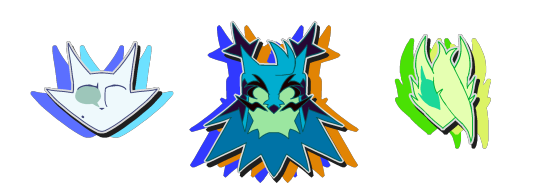
| WELCOME TO TROUTCLAN! (WE HAVE FISH!!!) |
"We have fish :)" — Silverstar, probably
🔷 START HERE!! 🔷
🐟 ALLEGIANCES 🐟
0 Moons (Founding Members) | 25 Moons (soon...)
🐟 TAGS DIRECTORY 🐟
#troutc moons — the moon tracker! this is where the story can be read #troutc art — all TroutClan-related art #troutc fics — written short stories featuring the TroutClan cats #troutc lore — any form of media (drawings, writings, etc) about TroutClan that happens outside of or behind the scenes of the moon updates #troutc memes — all TroutClan memes (includes drawings, incorrect quotes, and more) #troutc sprites — all of my designs are heavily stylized, so some people may wanna see how their in-game sprites look! #troutc asks — answered asks, for me and/or the TroutClan characters! #troutc updates — any updates related to the progress of TroutClan, which may include art wips, moon wips, in-game happenings, etc.
TroutClan Introduction below!
Silverwatcher formed many friendships throughout her youth as a wandering rogue. She kept the tradition of her Clan ancestry alive: by forming a Clan with her friends! They went on many whacky adventures, getting into trouble with Twolegs, even outsmarted a pack of wolves! But when most of them became senior warriors, with three friends called the Tricky Three joining them soon after (Violetkit, Tempestkit, and Flykit), Silverwatcher decided "all this traveling is fun, but let's find a permanent home to settle down & think about our future".
...And thus TroutClan became official! Once they settled into their camp, this was when Shiveringpaw (a RiverClan apprentice from seasons ago) met Silverwatcher in her dream, guiding her to the Moonshore, their source to StarClan, to receive her nine lives.
35 notes
·
View notes
Text
Guide to Understanding Genocider’s Many Names
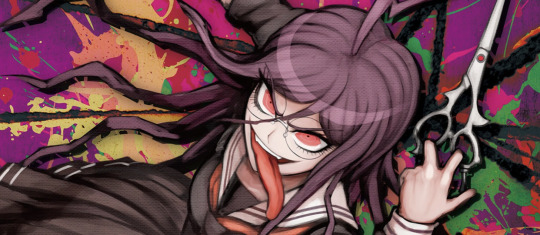
Genocide Jack has many names and it can be hard to understand why so many people use different ones or spell them differently, so I attempted to make a guide that is as comprehensible as possible.
Something to know before hand
Kanji: More complicated, such as 翔
Hiragana: Simple and smooth, such as しょう
Katakana: Simple and sharp, such as ショウ
Let’s get the “Genocide” part out of the way
This part of her name is written in katakana, (ジェノサイダー) and you’ll notice the line at the end. This means the sound is extended, so instead of “da” it’s “dā”. Japanese doesn’t have an “er” so this is used instead, since they sound similar. Her official title is Genocider. The localization simply switched this is be Genocide. I’m not sure why, maybe since Genocider isn’t actually a word, but that’s just my best guess.
Syo VS Sho
Here’s where it get complicated.
In order to make sounds like “kyo”, “bya”, or “ju”, two hiragana are need. First, a character ending in i, such as ki, bi, or ji, characters pronounced like ka or bu cannot be used. Second, one of the three y’s (ya, yo, or yu) in a smaller form.
The character “ki” (き), combined with “yo” (よ), would make “kiyo”. But if the “yo” is written smaller (よ→ょ) then the “i” from the first hiragana is replaced by it. So since きよ is Kiyo, きょ is Kyo. Same for “bya”. びや is Biya, so びゃ is Bya.
Now, we have our “exceptions”, shi (し) and ji (じ). You’ll notice they look very similar, which is why they are both “exceptions”. For “ji” (じ) and “yu”, (ゆ) rather than jyu it’s just ju (じゅ). It’s different since in the case of kyo and ko, it’s a whole other sound, but jyu and ju are pronounced the same, so the y isn’t needed.
But in all my examples, you’ll notice the first hiragana is two letters, which is why it gets tricky for “shi”. Like jyu, shyo is unnecessary, however, h and y are pronounced the same here, so you can remove either one and get the same sound.
Quick Note: I used “kyo”, “bya”, and “ju” as examples since there are Danganronpa characters with those in their names, but, just to clarify, they aren’t the only combinations possible.
The reason I put exceptions in quotes is because this is romanization, there is no rule book saying you must write it this way. While Sho is the most common way to write this, it doesn’t mean Syo is wrong. In fact, the games themselves use this.
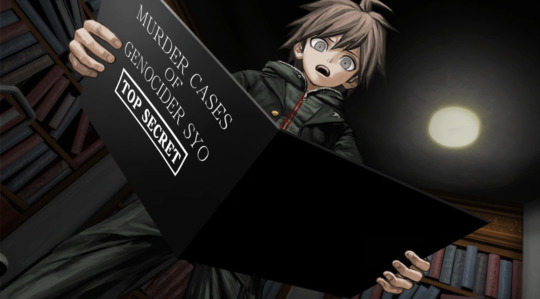
However, they also use Sho.

So, really, both are correct.
Syou VS Syo / Shou Vs Sho
> I’ll be calling her Sho/Shou here for convenience.
翔 should be spelt with a “u”, since it’s しょ“sho” then う “u”, so “shou”. Still, a lot of times the u is excluded because it doesn’t sound too different in English. English speakers pronounce “Shuuichi” and “Shuichi” the same, so I suppose the u is unnecessary. You’ll find this is common in a lot of different translations. Even Japanese media that use the alphabet, like the pictures above, will sometimes leave out the u, if following an o or another u.
Jack & Jill
These are just the titles that are strictly English. Since the whole thing about Syo in the beginning was that she’s a serial killer, society will assume it’s a man, so the public will give her a masculine name. In English, people will hear Sho and see it’s foreign, so there’s no gender association. I think it was changed that way so we’d see it as masculine. While I think they should’ve kept her Japanese name like everyone else in the game, I cannot deny how easily Genocide Jack rolls off the tongue.
Overall
All the names work, use whatever you want.
I hope this made sense to at least one person. If it doesn’t, feel free to ask for further clarification!
#danganronpa#genocide jack#genocider syo#genocide jill#genocider sho#praying I didn’t misspell anything
83 notes
·
View notes
Text
Seriously from a comms perspective I cannot stress enough how incredibly smart and strategic this launch/evolution/whatever you want to call it is. And to be clear I’m not saying it’s because they are PR. THAT IS NOT IT. Taylor and Travis are real people who happen to live in extraordinary circumstances that necessitate a plan in this regard because people can be so fucking weird about it.
The idea of acknowledging the elephant in the room instead of ignoring it and letting it take up space is what it all comes down to. Sure it was a frenzy when they first went public and the first bits of PDA hit the airwaves, but in the end what it does is normalize it. By this point, everyone knows they’re a couple and it’s not weird when they do hold hands or kiss or acknowledge each other in public. Because that’s what anyone would do with their significant other and trying to make it secret just makes it weird, for both the media and the people involved in the relationship.
So the way they’ve navigated this again has been masterful. There clearly are boundaries (it seems especially on Taylor’s end which Travis happily obliges) but that doesn’t mean they can’t just be themselves either. So, they’re not inviting people into their living room each week, but the gradual public meshing of their image served a purpose to normalize it. From Taylor’s first game to the occasional fluff pieces to trusted outlets to steer the narrative to acknowledging the public outings to dipping their toes in social media official, it’s making it so that now that they’ve moved into the next phase of their lives (whatever that may mean now but whatever it is it’s clearly serious and clearly considered permanent by both of them), they can share what they want without it being a stressor.
So if Taylor wants to be goofy, she can change her song lyrics or invite him up onto the stage and it’s newsworthy because she’s her but it’s not weird. Travis can be interviewed and be asked about his partner who is a public figure and speak highly of her without it turning into a maelstrom. Gradually their domestic status is going to be normalized so that their every move isn’t as big of a deal. (It’ll still be news because they are who they are, but it won’t seem like they’re sitting down for a root canal every time.)
I hate to call this a “rollout” because they’re people, not products, but in terms of a PR strategy, it’s excellent. And it’s not that every move they do is PR!!! It’s that every move they make is public, so they need to navigate that so that they can maintain their personal boundaries as they wish. It’s not that every interview is calculated, but it’s more that what they do or don’t choose to share at any moment in time is helping them figure out what they’re comfortable with, and it’s also lessening the market value, if you will, of any anecdotes. The more people become accustomed to them as a unit, the less each quote like this is bound to make huge headlines. (I mean other than fans like us because we want our pop star bestie to have everything she wants.)
It’s not just that their teams have set a great example, it’s that THEY are handling it with such skill and grace. I’m honestly blown away by it from a professional perspective and suspect that they figured out early on that getting a handle on it and guiding the narrative instead of pretending it didn’t exist might have been scary at first but has proven to make things so much easier and takes up way less space in all their brains.
#in other words DONT KEEP YOUR GIRLFRIEND LIKE A SECRET#like I said in another post I also strongly suspect why they’re dropping all this personal stuff now in a coordinated effort but#that will be tbc as we know#I don’t work in pr but let’s say something vaguely adjacent and I’m honestly like#I wish I could see their comms strategy and take notes lol#tnt#writing letters addressed to the fire
41 notes
·
View notes
Note
Oh wise guide with all the knowledge, if it's not a bother I always wondered where it's mentioned that in Loop's loops it rains because I played both games and I never saw anything like that.
It's been so long since I've played the prologue and I only ever played through it once in one sitting so I don't remember exactly where it's said tbh??? The only reason I think of such a vague detail at all is because it lives on in whispers among the fandom.
If anyone has the direct quote feel free to drop it here somewhere.
I'd normally direct you to the Script Project but I'm not sure if they actually have the entire Prologue script yet. Last I checked they didn't. (They're working hard on doing a lot of stuff at once, I'm pretty sure. Like adding the Japanese text from the official Japanese translation, and a search feature. So Start Again is probably lower on the priority list)
17 notes
·
View notes
Note
I don’t know if this would count but I had an idea to rewrite A.I. (from Poppy Playtime Forever that Roblox game I mentioned before) into the AU …
anyway here we go-
He used to be an Orphan named Oswald Memeswald (not his real last name, he made it up when in his old orphanage before playcare he was the only one who hadn’t had a last name (the second E is silent)) after a year in playcare he was selected to be a bigger body (partially as a test to see if they could ‘deal’ with Harley Sawyer (turning him into a digital conscious) )
his purpose at first was giving tours, but when the factory hired more staff for tour guides he was turned off. leaving him alone with nothing but his thoughts for years, driving him to utter lunacy.
his appearance is the same as the original game that he showed up in (his physical body was turned into the same thing as the image I sent in that previous ask ) (Including the TVs he shows up on in the game, they we’re taken down when they got rid of him the first time and reinstalled when he was found again) )
when he was found and reactivated he was moved from tours to security (as he was too insane to properly give tours anymore),
he helps huggy catch intruders (based on how A.I. controls huggy in said game), and to be clear he was only brought back recently (like about 6-7 months before the modern day in the AU).
i don’t know if this counts as only Half of him is an OC and the other half is a non canon but official character
but either way I tried
here’s a (goofy ) image of Oswald from before he became A.I. (I honestly have no idea what I was doing i don’t even remember drawing him but I recognize my iffy art style guess I drew him half asleep… or something)
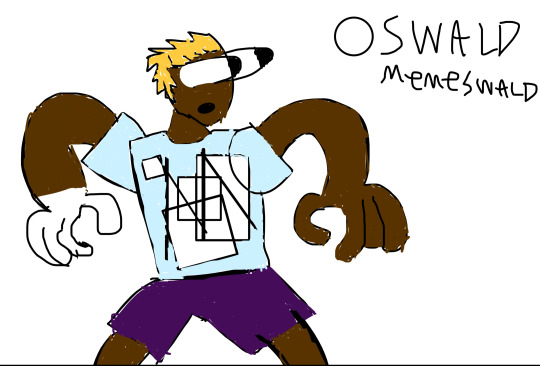
Extra details
-due to being isolated for YEARS he’s VERY clingy to others (based on my interpretation/headcanon of the game like most of his character)
-he actually finds the adult experiments fun but doesn’t like Dr Bruno White or Mario Gerald Rachels as those two were the ones who made him what he is, and the ones who turned him off and locked him away. So in short despite liking pretty much everyone he HATES those two (so Coo-Coo & whatever Bruno white’s experiment form is )
-He would definitely “play” in the game station with mommy long legs when he gets lonely (and mommy is angry ( if im remembering her lore for this right…) and everyone else is busy (“play” in quote marks as he’s not actually there )
-he’d provide witty commentary on pretty much everything, including the orphans doing random crap in playcare
-he sees handyman as a big brother figure (due to both being based on the yellow guy model playtime co uses for tutorial Tapes ) how handyman responds to this I’m not sure yet…
that’s all for now
🪽Added to the list!
7 notes
·
View notes
Text
[Book Rec + Reaction/Thoughts] The Lantern and the Night Moths 灯与夜蛾 by Yilin Wang
An anthology of translated poems by five modern or contemporary poets and accompanying essays by the translator, @yilinwriter.
You can find the pronunciation guide and list of corrections here!
The cover art, a beautiful expression of the tone of this collection, is by Taiwanese artist Ciaoyin (check out her gorgeous insta!). I'm looking forward to the arrival of the physical book as my tab absolutely does not do it justice xD

Anyway! The official release date is 02 April 2024 though there have been some very thoughtful reviews by early readers already. Here, here, here and here.
(It was an ARC that I received too… though in the time it took to put this together, the ebooks have already gone out to readers >.< typical snail yj!)
Instead, I’ll tell you who I think would be interested in this book or might benefit from reading it, then share things that are cool about it from the perspective of a bilingual hobbyist translator + lover of ancient poetry and lyrics.
Who should read it?
If annotations, translator’s notes and reflections spark joy for you...
If you’ve ever read poetry translations and been intensely curious about what goes on under the hood...
If you’re a translator yourself wanting to hear another voice...
Definitely check this out!
Also if you’re CN+EN bilingual and have ever read something in English that references Chinese terms and concepts etc. except ONLY in English, pinyin or wade-giles and been utterly frustrated by the ensuing guessing game (like me) Fear Not.
That will not be a problem here.
I really appreciate how Chinese words are used naturally where needed for concepts and quotes - they are also translated for those who can't read Chinese so no one is left out. It made this book of and about translation (and more) super comfortable to read! The solution is so simple, so direct, so rarely used that I am amused.
Oh, but do note that the Chinese characters are in simplified though!
The poems are organised by their writers who are listed here by order of birth year, not appearance in the book:
秋瑾 (Qiu Jin, 1875 to 1907)
废名 (Fei Ming. 1901 to 1967)
戴望舒 (Dai Wangshu, 1905 to 1950)
小西 (Xiao Xi, 1974 to _)
张巧慧 (Zhang Qiaohui, 1978 to _)
Altogether, that covers nearly the last 150 years up to now. I’ve never really been into poetry by poets in such relatively recent times, in part because I’d been holding on to this stereotype of them spurning Classical Chinese and ancient poetry in the first half of the 20th century (not entirely true, as I came to realise xD). It made sense and was understandable, but felt sad.
Yet am I the target audience for this book?
Very much so.
In ways I didn’t think I would be too! It was so much fun to experience this both as a reader and a translator that I thought I’d share it here, where we are appreciating Chinese poetry together.
If you didn’t think you’d enjoy modern Chinese poetry, hey, give it a chance!
Oh yeah - on the way home a while back, I was talking to a friend about translation and was surprised to hear that her impression was that it ought to be a straightforward process. Like isn’t it a 1:1 conversion? At some point, ‘what’s the difference between something google translate might return, and how you would say it?’ was asked, and oh that was a delightful question to my ears! I showed her one of my comparison sheets where an original text is laid out alongside multiple translations line-by-line, briefly explaining some common and unique choices and how the people who had translated those probably arrived at the various interpretations. She was pretty amazed to see that the answer to her question was: very different. Hey, it’s a complicated process!
But there’s only so much one can explain in the space of a train ride. That’s why The Lantern and the Night Moths is a book I would also rec to someone like this friend of mine - open minded and curious but never having the chance to think about or encounter the craft of translation.
Like Yilin says, ‘the meaning of a word cannot be fully expressed in one single translation, nor through a series of translation attempts’. She then explains why with great attention to detail and some solid examples from one of the poems with word choices loaded with subtle connotations :D
What's interesting about it?
Okay, for one, Yilin shared a playlist of music that she listened to while working on this book. Here is the link to the spotify one and the one on youtube. Check them out! They sure put me in the mood to read xD (favs: 别知己, 小神仙 & 去有風的地方) Afterwards, this made so much sense like - ah! an audio moodboard.
She's also putting together these adorable mini profiles of each poet along with a cmedia and tea rec to match their vibes. Go see them on her instagram xD
Now to business...
structure
What really helped keep the reader’s focus was the way each section is organized, how the poems and accompanying essay were presented and finally the short bio of each person right at the end.
The poets are first introduced through five or six of their poems, works well suited to this purpose. Their voices, distinct through the vision, ambition and emotion of their words, are brought across by Yilin’s sensitive, thoughtful and poetic translations into English. These translations were also creative and transformative in a way that made so much sense after reading one of her reflections on the process, how she ‘must guide it with gentle hands to ensure its spirit is kept alive and intact during this transformative, and often excruciating process’. A rebirth into another language!
Personally, I’ve come to think of reading translations as looking at a work through another’s eyes. So it’s delightful when the translator’s presence is discernible, and even more so when the reader is given insight into their intention and process via commentary.
Yilin’s essays coupled with the poets’ bios at the end provide a means to go back and appreciate their works in context of their circumstance and inspirations. Similarly, to read the translations with a changed perspective.
I don’t know how much of a thing this is with translated poetry anthologies in English - can count the number I’ve read with both hands lol, and they’re all of the ancient chinese poetry variety - but I really like this design.
drawing on poets who came before them
Remember how we’re always recognizing traces of inspiration from ancient works (to them) in poetry of the various dynasties? 李商隐 Li Shangyin of Tang for example, was influenced by 楚辞 Verses of Chu and folklore and mythology such as that in 山海经 Classic of Mountains and Seas, 李白 Li Bai frequently references poets and history of the 魏晋 Wei-Jin era, and 王维 Wang Wei was clearly familiar with Buddhist scriptures which were translations themselves!
Just like the late Táng poets whom he praised for boldly deviating from the voices before them, Fei Ming used popular references and tropey shorthands ‘in contexts utterly different from the original, reimagining them anew’. Dai Wangshu, too, ‘boldly re-envisioned what modern poetry could look like by revisiting the classics’. In fact, in his very relatable ‘To Answer the Visitor with Classical Imagery’, I see Li Bai’s 春夜宴桃李园序, Qu Yuan’s 离骚 and lots of - as the title says - classical imagery, as if pulling out painting after painting to describe a feeling.
And Dai Wangshu’s faith in the translatability of poetry, that ‘poetry isn’t what is lost in translation, but rather, what survives it’ reminds me of what a friend, @xiakeponz, said that I agree with so much - because readers can ‘experience something in their own individual way through (your) shared humanity rather than language alone’.
poetic tradition and beyond
Between the lines of contemporary poets Zhang Qiaohui and Xiao Xi, I can really see the charm of plain vernacular, how it can be beautiful, incisive and clever in turns. Even as it seems to have moved further than ever from the structure and language of literary Chinese, the themes that inspired common motifs remain a part of life. Mother and divinity, homesickness, finding oneself, tributes to admirable spirits and the issues that trouble society - just in a new form and with different ways of expression.
Qiu Jin
So many FEELINGS about what Qiu Jin was doing - ‘I awaken the spirits of women, hundreds of flowers, abloom’. I would love if she could see the world now. So many things for her to rouse and fight against, but at the same time just as many to be proud of. I am so in awe of her, but now hearing her loneliness and struggle there is a soft spot in my heart for those too.
conclusion
So so so…
Qiu Jin’s admirable fire and lonely resolve. Zhang Qiaohui’s precious ability to express beauty in the mundane and in pain. Fei Ming’s utter delight! He is having so much fun and when* I’m vibing, I feel it too. Xiao Xi’s critical eye and keen observation of the world. Dai Wangshu’s whimsical charm and passion for translation. Finally, Yilin Wang, the connecting thread wound through them all, bringing them together so that we may be acquainted.
*Reading his poetry is like unwrapping a seamless, many layered present. A gift that keeps giving - if only you have a key 😅 Fortunately, Yilin has halved our struggle 🤣
I’ve had such a great time with them all. And if you come, I hope you will too!
#The Lantern and the Night Moths#chinese poetry#Yilin Wang#poetry in translation#灯与夜蛾#Qiu Jin#Zhang Qiaohui#Fei Ming#Xiao Xi#Dai Wangshu#rambly reviews#i read from Fei Ming onwards on my kobo LOL but that one has no colour so...#i might do more of these review-y rambles about poetry things if y'all are interested?#i've been reading LOL#some are chinese some are english#all of them fun and enlightening
43 notes
·
View notes
Text
Valicer In The Dark -- The Three Pillars' Menagerie
Yes indeed -- I've talked a lot about the human members of the group, now it's time to discuss the nonhuman ones! Because, as it turns out, the Three Pillars are going to actually end up with a fair number of pets over the course of their adventures:
Sooty -- the very first "pet" the trio ever get, Sooty technically predates Victor, Alice, and Smiler becoming the Three Pillars, as he shows up before they become an official crew. His first appearance is in the upcoming second VITD story, "A Murder Shared Is A Murder Thirded" -- well, his first solo appearance, at any rate. For you see, Sooty is one of the ravens in Elder Gutknecht's tower -- a recently-fledged youngster with a few lingering baby feathers near the tops of his wings. When the trio temporarily moved in after the whole Barkis incident, Sooty was very curious to see what was going on with these new strange solid people living in his house. His curiosity was rewarded with food, so he decided that whoever they were, they were nice. So when they headed off to snatch Bumby's ledger (and hopefully kill the guy), he flew after them to see where they were going and if it involved more food --
And when Bumby confronted the trio after discovering the theft of his ledger, intending to stop them by any means possible before they could escape and expose his evil, Sooty realized that this other weird solid person meant the three nice people who fed him harm -- and promptly swooped in to harass him. Giving Alice the perfect opportunity to grab her sister's room key off Bumby's watch and shove an armed electroplasm bomb into his pants. Sooty ended up hitching a ride on Smiler's shoulder when they fled the scene, and Smiler ended up using Sooty as a messenger to let Elder Gutknecht know what had happened and where they'd gone after the trio ran into their parents, Matt and Carol, and were invited to spend the Names (night) at the Ministry of Joy. Sooty performed this job admirably, and thus became the Representative Of The Tower Ravens for the trio when they officially moved in. Sooty is closest to Smiler, who was the first to feed and pet him, but he likes all three of the trio and will often hang out with them as they do various tasks. You know that anonymous raven that so often popped up in the various Valicer In The Dark-themed Not Incorrect Quote collections? Yeah, I'm picturing that as Sooty now. :) He's their bud! And, if you believe the second set of quotes, toilet trained. XD (Also, I should thank @thesatiricaldemon for giving me the idea of Sooty showing up to harass Bumby at the climax by mentioning how bad an idea it is to piss off a corvid in his comment on the last chapter of "Start At The Beginning...Sort Of" -- Bumby may not have made enemies with the whole flock, but he definitely made one of that one particular raven!)
Guide -- if you've read my Forgotten Vows series, you'll recognize this as my name for the white cat Alice keeps seeing periodically during Alice: Madness Returns (the one who appears most prominently in Chapter One of the game, where chasing after it leads Alice to the spot where she meets Witless -- it also appears briefly at the beginnings of Chapter Two (on the docks) and Chapter Four (at the door of the police station) ). While Guide had a decent life as a semi-feral stray who hung out in Dr. Fixxler's shop from time to time in the Forgotten Vows Verse, I thought it would be nice if, in this universe, Alice could officially adopt the cat. And after a little bit of thought, I realized that I already had the perfect score in which this could happen -- the Alice: Asylum-based "taking out Radcliffe and rescuing his daughter Angela" score! My idea is, after the trio makes the decision to try and shake down Radcliffe for Alice's inheritance, the white cat shows up while they're on their way to his house. Alice recognizes her (as I've decided the cat is female) and says, "I appreciate it, but I really don't need you to show me where I'm going this time" --
And then they come across the clearly-abandoned house and she's like, "...okay, maybe I do." XD And indeed, after discovering Radcliffe's plans for his daughter and where he's likely to be, the cat helps lead them to the meeting place at the docks (annoying Rabbit a bit, as he's trying to do the same thing), and maybe, like Sooty, even helps in taking him down (perhaps biting or clawing him at a key moment?). And then, once everything is sorted and Angela is safely settled in Houndsditch, Alice spots the cat following them again as she, Victor, and Smiler are heading home...
And when she sees Alice looking at her, the cat pads up to her and starts rubbing against her leg, purring. Alice is like "well, I let Angela have my old rabbit toy, so I do need a new furry white creature in my life," picks her up, and takes her home, naming her Guide because, well, that's what she seems to do. There's a little initial tension between Guide and Sooty and the other ravens, but after it's made clear to Guide that these birds are not flying snacks, they get along reasonably well. Guide is naturally closest to Alice, often chilling with her as she reads or draws, but will of course accept pets and food from both Victor and Smiler as well.
Dogmeat -- yes, that Dogmeat. The German Shepherd from Fallout 4, to be precise, since that's the game I'm actually playing. I told you all in the above-linked post that I wanted to adapt some FO4 quests for my VITD universe -- and if I'm bringing in Nick Valentine, Piper Wright, and Preston Garvey, why wouldn't I also include everyone's favorite doggo companion? Especially since one of the quests I'm adapting is "When Freedom Calls" (the one where you meet Preston and help him defend the Museum of Freedom from raiders), which:
A) I imagine most people do with Dogmeat at their side, given the quest location is literally just down the road from the Red Rocket where you meet and adopt the dog
B) I've always headcanoned as a quest you should do with Dogmeat, as -- thanks to Mama Murphy being the one to tell you his name and acting at least somewhat familiar with the pooch -- I've always pictured Dogmeat as having traveled with Preston and the survivors for a bit before they all got pinned down in the museum, and that Preston actually sent the dog out to try and find help during a quiet moment -- hence why Dogmeat was at the Red Rocket in the first place!
So yeah, it only makes sense that Dogmeat would be a part of the VITD version of the quest! I'm still pinning down how the quest should go in this reality, but here's my off-the-cuff rough draft so far --
I. The Three Pillars are walking around Six Towers one day, maybe talking about plans for their next heist or something, when they encounter Dogmeat hanging around an abandoned building (perhaps whatever the equivalent of a gas station is in this world? The rich DO have electroplasmic carriages that work a bit like cars, and might need places to renew their fuel supply for the engines...). Victor of course promptly takes a shine to the dog, and the dog to him. After a bit of getting-to-know-you time, the dog indicates that he wants the trio to follow him -- curious, they do --
II. And come across the wreckage of an old museum, with a man on the balcony, being menaced by a gang of toughs. A gang that promptly turns on the Three Pillars once their presence is known. Fortunately, the trio and the dog manage to defeat them and drive them off for a bit, and the man on the balcony asks them to come in -- they do, and find him locked in an upstairs room, along with four other people, looking rather worse for wear. The man introduces himself as "Preston Garvey, of the Coalridge Dust Street -- just Preston," and the others as Mama Murphy, Jun and Marcy Long, and Sturges. They fill in the Three Pillars on what their deal is -- basically, they're the survivors of a recent massacre on Quincy Street in Coalridge, after a rich factory owner decided to make an example out of striking workers by sending mercenaries (a Hound group called The Gunners) to rough up their loved ones. Things quickly got out of hand, though, and a lot of people ended up dying because the Gunners were a little too enthusiastic about their job. Preston was part of the Bluecoat squad that was sent to try and calm things down, and for a minute it looked like they might actually succeed...
Only for one of his own squadmates, Clint, to reveal he'd decided to switch sides and join the Gunners, leading to him helping them gun down his own squad. Preston was the only survivor thanks to managing to wound Clint and flee before he could kill him, but he couldn't stand up to the Gunners all on his own. So, determined to save someone in this mess, he found these four, put them under his protection, and then booked it out of there. Unfortunately, Mama Murphy had a reputation in the neighborhood for being a little psychic, especially if she's high. A reputation that Jared, former resident and leader of the "Corvega Raiders" (a gang of former workers from the Corvega Electroplasmic Carriages Company) knew well, thanks to her predicting he'd become a feared gang leader when he was a child. He decided upon getting control of the Corvega Raiders that he wanted her and her insights for himself -- so almost the minute the group got free of the Gunners, they found themselves harassed by Raiders sent to kidnap her. The group managed to evade them long enough to get to Six Towers and barricade themselves in this museum, and -- well, it's been a stand-off ever since. And while Preston was very impressed with the Three Pillars' work in helping drive off the Raiders, he's pretty sure the gang is not gone for good. The trio, feeling very sorry for these people, offer to help try and defeat the Corvega Raiders once and for all and get the refugees to safety. Preston is quite thankful, and they start discussing offense and defense options.
III. During these talks, Victor ends up chatting with Mama Murphy, who tells him that she's glad Dogmeat found them. Victor's like "oh, he's your dog?" and she explains that he isn't, not really -- Dogmeat has been traveling with them for a bit, and Preston did send the dog to find help when they got trapped in the museum, but he's not anyone in the group's pet. He's just a dog that showed up and started traveling with them (the "Dogmeat" name was a joke by Marcy that stuck). Mama's of the opinion that Dogmeat came along just to help get them out of this mess, and now that he's done that, he'll probably stay with Victor and his companions, since he seems to have bonded to him. She also warns Victor that she's had a vision of something bad showing up during the next fight -- she can't describe it well, but she knows it's big and angry. Victor, concerned, says he's going up on the roof to watch for trouble then, and does that while Alice and Smiler help Preston come up with more ways to repel potential invaders (Smiler probably working up some handy-dandy knockout bombs with the help of Sturges)...
IV. And then -- as the Corvega Raiders show up for a second round and starts falling afoul of the bombs and whatnot -- Victor suddenly feels the big and angry thing himself, coming towards their location rapidly. A big and angry thing that he's able to identify as a Horror that's somehow managed to get into the sewer system. He runs downstairs and warns the others --
Just in time for the Duskwallian equivalent of a Deathclaw (a Glowing Deathclaw, no less) to rip its way through a manhole and emerge onto the streets. It makes short work of the gang outside, but now the trick becomes keeping it out of the museum so it doesn't make short work of everyone inside! The Three Pillars are successful in this (either killing it, as in the original quest, or at least keeping it out long enough for the Spirit Wardens to show up and kill it), and Preston thanks them profusely for their help. He says he hopes to get the refugees settled here in Six Towers (Smiler promptly recommends the Advocate bunkhouse by the Arms Of The Weeping Lady soup kitchen, natch), and then start up his own group to help take down his traitor squadmate and maybe do something about the crime in the city. The Three Pillars wish him the best with that, and after seeing the group safely to said bunkhouse, start heading home...
V. And sure enough, Dogmeat tags along after them, tail wagging. Victor is like "well, I hope you get along with cats and birds," and the dog joins the group at their headquarters. :) Once again, there's some early tension between Dogmeat, Guide, and Sooty (Guide is naturally suspicious of the big dog, while Dogmeat doesn't particularly like Sooty always trying to steal his food), but with a firm hand from the human trio, it's all sorted out. And much like Smiler is Sooty's favorite, and Alice Guide's, Victor is Dogmeat's favorite, with the dog generally going to him first for affection and playtime. Like, he'll take a belly rub from everyone, but Victor gives the best ones, in his opinion. :p
Dougie -- okay, this is an interesting one. Back when I was first creating the Valicer In The Dark verse, one of my very first story ideas involved the trio quite accidentally getting a new pet on a job. Specifically, it involved Victoria -- annoyed at her parents for being all smug about this new fancy silver egg retrieved from the Deathlands that they bought at a very high price, as if it wasn't her husband's money that paid for the damn thing -- hiring the Three Pillars to humiliate them by stealing it. Victor, Alice, and Smiler, upon being informed of the situation, are only too happy to cause problems for the Everglots (they have not forgotten the whole "Barkis" thing, and neither has Victoria), and successfully steal the egg, intending to sell it as soon as possible --
But. At some point during their escape (I haven't decided when yet -- it will probably be the consequence of a bad dice roll), Victor, who has the egg hidden in his coat, hears a crack! And when he goes to investigate, worried they damaged the egg --
He discovers that the egg was in fact a real egg. That just hatched a tiny baby dragon. A tiny baby dragon --
That just so happens to be based on my own beloved plush dragon Dougie! :D You know the one -- they show up sometimes in the posts I make for my Victor Plush and Alice Dolly's birthdays. The long silver dragon with the copper-colored head crest, "ear" fins, claws, and underwings. You can get a good look at them in this old photoset from shortly after I got them. They're called "Dougie" because they're a Douglas Toys product, and I'm not very creative with names. XD I love them very much and wanted to involve them somehow in this verse, and this seemed like the best way to do it.
Anyway -- as you might imagine, everyone is very "?!?!" about this development when Victor shows Alice and Smiler what's happened. Fortunately, they still manage to get themselves and their new surprise pet out of the house safely, and then head straight home to raid Elder Gutknecht's library because what the fuck. XD They eventually learn that Dougie is in fact a "lap dragon" -- a type of dragon specifically bred to lie in people's laps and keep them warm. Admittedly, these dragons were supposed to have died out along with a bunch of other stuff eight-and-a-half centuries ago when the sun got exploded, but (as per Elder Gutknecht's theorizing) either those eggs can last for ages and only hatch in ideal conditions, or some survived and are now breeding wild out in the Deathlands, unbeknownst to everyone else. *shrug* At any rate, the book tells them that Dougie's not going to get very big (my toy is sixteen inches long, so about that size) -- and more importantly, they're also not going to be able to breathe fire. All of his warmth stays inside them so they can do their job. This latter trait means that Alice doesn't have any objections to keeping them (especially since she can see that Smiler and especially Victor have already fallen in love with the creature), and so Dougie joins the pet group! There is a lot of "???" from the other pets about this strange creature, but they soon get used to them -- in fact, when it becomes very clear that Dougie is a good source of warmth, Guide and Dogmeat in particular like to cuddle up to the little guy. Though, naturally, Dougie's favorite place is on Victor's lap. :) What can they say -- they love their "mama!" And he loves them. :)
Us -- and finally, we come to the one that I feel the weirdest about calling a "pet" because, well -- this is our favorite intellect devourer friend from Baldur's Gate III, acquired by the gang in that score I talked about previously that's a rough adaptation of the opening tutorial dungeon on the crashing Nautiloid (the one that features themselves having to drop themselves into the ocean on a lifeboat before they're torn apart by air demons attacking a crashing airship). And while Us may be very new to the world, and a weird brain-with-legs-and-tentacles creature, they are fully sapient! I guess they count in a technical sense because they disguise themselves as a cute little kitty cat so only Victor, Alice, Smiler, and anyone they choose to let in on the secret (like Smiler's parents and Elder Gutknecht) can see them as what they are, but... *waggles hand* Still a little weird to me. They are a beloved member of the family, though -- even if the teething problems in introducing them to Sooty, Guide, Dogmeat, and Dougie are worse than usual because the animals' reactions to Us are a combination of "WHAT THE FUCK IS THIS CREEPY THING" and "hang on it smells like food." Fortunately Us is quite capable of defending themselves, and a few tentacle smacks on the nose and perhaps a minor psychic blast or two teaches the animals that they are NOT to be nibbled on. I don't know how comfortable they ever get with the intellect devourer, but it does kind of amuse me to imagine them all in a big cuddle pile one cold winter's night, so...I guess comfortable enough? XD Smiler certainly loves them a lot, though -- they bonded with the creature the minute they pulled them out of that poor dead guy's skull, and the feeling is very mutual. Victor and Alice -- well, they need a minute, but they rapidly warm up to them. Helps that Us is so cute -- and, in Victor's case, can eat his fear and anxiety about stuff!
Whew -- quite the collection, huh? Even I didn't expect them to get this many pets...good thing that they live in a reasonably-spacious house and all love animals! And that these animals are all capable of taking care of themselves when the crew is out on a job. XD And damn it, now I want to do some sort of story with the pets all teaming up to find the Three Pillars when they don't come home one day and Us suspects they're in trouble...
#valicer in the dark au#pets#worldbuilding#storybuilding#guide#alice madness returns#sooty#blades in the dark#dogmeat#fallout 4#dougie#dragon#us baldur's gate 3#baldur's gate iii#yeah I was thinking about this a while back and was like#'they get a lot of pets I should do a quick post about them!'#said quick post: takes me multiple weeks to draft out properly#and results in me both finally figuring out basically what I want to do for the VITD version of 'When Freedom Calls'#and coming up with a NEW story idea#because this universe is THE MOST INSPIRING THING EVER FOR ME#*sigh* yes brain I'll add it to the list#to be fair it probably would be funny#and honestly the pets probably count as cohorts#like not the typical type but#I could give them proper edges and flaws and stuff#list them on the official crew sheet#...I'm totally going to do that aren't I? XD#I guess look for an update to this post when that happens!#queued
12 notes
·
View notes
Note
The text connecting Chris and Jill is “戦友” or “kanyuu” which translates to “commrade in arms; war buddy”.?
in the Revelation's bio for Chris, they called him Jill's Brother-in-arms.?
So they don't have feelings for each other?
https://www.tumblr.com/chirikalovesjill/34500920927/where-did-this-picture-come-from-please-anyone
Hello Anon! I want to start off by saying that it's okay if you don't ship Chris and Jill romantically - not everyone does. I mentioned in a previous post how I can certainly see how others would only view their relationship as platonic or coworkers. Unfortunately, the link in your question does not work so I'm sorry I can't respond to that in particular. And I am not trying to sow any discontent or attacking, I'm merely responding and enjoying my preferred ship. I hope you can understand. If we can all stay positive and respectful that would be greatly appreciated. ^_^ Chris and Jill have been fighting BOW's since the very first game. Actual canon is that they survived through the whole mansion together. They've always protected each other. So 'comrade in arms', 'war buddy, 'brother-in-arms', 'partner', 'bestest friend', 'kindred spirits', 'love of my life' are all titles they would/could use to address each other.
Also, in RE1 original, Chris and Jill were written to be romantically interested in each other. In a recent interview, the live-action actor for RE1 Chris stated that he wanted to remain as respectful as possible to Jill's actress as she was much younger than him and he knew they were supposed to be romantically linked in the story. Source: ROE Plays RESIDENT EVIL 1 w/ Original Chris Redfield (Charlie Kraslavsky)
And this cute song that plays when they are reunited: Long Lost Friend Long Lost Friend Revisited - I love how bittersweet this is, very fitting In my mind, there is definitely some romantic sweetness to this song. But Capcom likes to keep them ambiguous or seems to want to retcon them, so I don't know. Ship them or don't. Doesn't really matter in the grand scheme of things. I just like how mature their relationship seems - built on lasting trust and respect. Even in Death Island there were ambiguous hints of something more between them. Like, Chris staring at a smiling Jill, backlit by a beautiful setting sun, seems kind of romantic to me. ... Only to fist bump her seconds later. Guess he wanted to keep it professional and clean in front of his sister XD
Before I got into Resident Evil (Biohazard), I never really knew about any 'ships'. I had vague memories of RE2 (Cleon bby) and RE5 (my unknowing teenage self actually shipped Sheva and Chris!), but it wasn't until I actually replayed the games as an adult and explored more of the extended lore that I became a Valenfield fan (and unexpectedly, less of a Cleon shipper). And what cemented it for me even more was the supplemental RE5 guide translations!
I highly recommend any Valenfield shipper to read it here. (scroll down a little more than half way on the page to find the STORY section. It's after the different colored text timeline.)
Some quotes from this official guide book:
... Referred to as "the BSAA's ace", Chris has a brilliant track record preventing many bioterror attacks, but Chris' chest is filled with an indescribable emptiness. Many comrades have been sacrificed to repair the errors of fools. Even if the world's saved, these friends will never return. He had lost his irreplaceable former partner. ...
... Chris has nothing against having a female partner. In fact, the partner he regarded as irreplaceable was a female too. She's the perfect person whom Chris can totally trust and rely on, someone whom he believes is what he needed to complete any mission. Chris felt their teamwork was like an eagle able to escape from biohazardous danger. ...
... Chris is staring intently at a statue of a sleeping beauty. He's like a person looking at his lover through a mirror, where the other side of the mirror's a different dimension. ... The image displayed on the PDA screen issued by the BSAA isn't very good quality. The faint face is illuminated by a weak light, ... Despite that, Chris is able to recognise the person. He's been chasing this lead all the while, just so he can repair the missing piece of his heart. This can't be a mistake, nor an illusion. This is a fact. ... It's Jill, his old partner who sacrificed herself and jumped off a cliff in order to save Chris. Due to Jill's absence ever since, the BSAA have removed her from duty. But two years later, there's finally a sign that shows she may be alive after all, and this sign's appearing right in front of her partner who refuses to believe she's dead. The reason why Chris, who was from BSAA North American branch, was hoping to join this operation within Kijuju, was because he'd obtained some sort of lead leaked by Irving on the black market while he was looking for Jill. ...
... Jill, with her antibodies, has been administered P30--- Gifted with superhuman abilities, she's been given a powerful drug that controls her mind too. This evil drug is continuously injected into her body, torturing her to no end. Just as Wesker intended, Jill's receiving hell-like suffering. "I'm begging you, kill me!" ... Wesker's instruction to Jill before he leaves, which is to kill Chris who has finally come for her, plays mercilessly in her mind like an echo. The painful, unbearable order's destroying Jill mentally, and she's begging with her mind for her old partner, Chris, to end her suffering. "Don't worry about me! If this goes on I'll only end up killing both of you! Shoot me, please!" Despite that, Chris refuses to give up. Chris screams like a beast at the brainwashed Jill. He promises that even if it means giving up his life, he's going to free his partner with whom he has finally reunited, from her curse.
But again, I believe Capcom will keep their relationship more ambiguous and open to interpretation - I think they want to keep all potential shippers content. And they certainly seem to be moving towards a more 'just a good friend/co-worker' angle than before.
Which, in my opinion, cheapens the over arcing story (RE1 - 5) and relationship - but that's for another post to ramble about, I suppose.
No hard feelings if you're not a Valenfield shipper. They have a good friendship and I can totally understand if people only see them as that and nothing more.
#valenfield#just my own annoying ramblings - don't mind me#platonic comrades or secret soulmates - they're cute either way#answer#what do I know? I'm just a shipper ;;#resident evil#I'm sorry if I sound like I'm stuck on repeat :P
42 notes
·
View notes
Text
Alice Liddle: American McGee's Alice
MASSIVE TRIGGER WARNING: THESE GAMES AND THIS POST WILL BE DISCUSSING THEMES OF S.A, PEDOPHILIA, MURDER, MENTAL ILLNESS, SELF HARM, PROSTITUTION, AND MEDICAL ABUSE.
Alice Liddle of American McGee's Alice and its sequel, Madness Returns, is a severely mentally ill character in the games she stars in. She endures trauma after trauma, with next to no assistance, alone. In this post we will break down what happened to her, her reactions, and how she developed.
Disclaimer: Despite mental illness being the main theme here, I will not be attempting to diagnose Alice, as I am not professionally trained and she does not have an official, canon diagnosis of any kind. I will however make inferences.
For those unaware, American McGee's Alice is a horror twist on Alice in Wonderland, following the protagonist Alice. In this first game, you play as 18 year old Alice Liddle, who from eight years old to that point has been living in Rutledge Asylum in England. The game begins with the player introduced to the catalyst of Alice being in the asylum: a house fire.
In this fire, Alice is the only one to survive from her family, with her parents and sister, Lizzie, dying in the fire. This causes a massive snap in Alice's mind as she watches the house burn and townspeople surround her.
In this scene we are also introduced to the idea that Alice was likely already mentally ill, as when the fire begins, what wakes her isn't the smoke or screams, its Hatter and March Hare screaming in her dreams about the fire, begging her to wake up. (However, its likely it was just a framing device, but we do see its what woke her.)
From then on, Alice spent her time in the asylum, nearly comatose. She was catatonic and would only speak in shrieks and shrill screams. She'd have seizures and episodes of hysteria before falling unresponsive and mute again. Her doctor's notes also describe an incident where she "wielded a spoon like a knife and the orderlies, then turned the makeshift weapon in her own arms".
Needless to say, the fire that killed her family severely traumatized Alice, and she struggles heavily with possible PTSD and survivors guilt.
Alice in the first game also expresses suicidal ideation, or at the very least a passive desire to die. She's heard saying, "Save myself? From death, is that it? Is that why I've come here? I'm not afraid to die! At times I've welcomed death..."
And, "Everyone I love dies violently; unnaturally. I'm cursed! Why go on? I'll just hurt others."
The latter of these quotes is indicative of her guilt; it shows she blames herself for not just her her family's deaths, but others, and believes those she grows close to will also die horribly if they stay around her. She expresses she thinks people are better off without her.
In regards to Wonderlands occupants and how they relate to her fragile and broken psyche... American McGee has stated that all in some way represent her fragments mind and emotions. How, I don't think is explicitly stated beyond the Queen, but I have theories:
Cheshire: Her subconscious and manifestation of Dinah in her mind. Dinah lead her to safety in the fire, showing the way out. Chesh is guide that knows more than Alice consciously knows, but things she's got hidden in her mind. He tells her the clues she's seeing and picking up on subtleties she can't. That's why he uses riddles.
Hatter: Hatter is obsessive and rambling. He's a sort of representation of her doctor in the asylum, after all he runs one himself. He's paranoid and obsessed with time and loathes mechanical malfunctions. He may very well be a sort of ego aspect, where the Queen is super-ego. He could also likely be the manifestation of Alice's own paranoia and frustration surrounding her own "malfunctioning" mind.
Queen of Red Heart: She is Alice. She is the part of Alice that causes her the most grief and torment. She is what keeps Alice locked in her psychosis; a malevolent manifestation of super-ego. Cheshire compares her to a cancer in the body, which must be excised or Alice would die.
Jabberwock: A creature who taunts Alice and accuses her of not caring about her family. He is what taunts her about their deaths and says that she was, "in dream land taking tea with friends", and she, "couldn't be bothered". He is her guilt and self anger and he is there to remind her of this guilt constantly.
Caterpillar: He provides her wisdom giver. He takes things she sees and can help her recontexualize them. He is similar to Cheshire, but more to the forefront. He is also seemingly the calm part of her mind.
Tweedles: looking identical to the orderlies in Rutlidge, the Tweedles are cruel to Alice and lack any higher intelligence beyond orders. They are childishly cruel and likely have something to do with Alice's self punishment.
Rabbit: More obsessed with time than Hatter, Rabbit is a mostly absent guide who rushes ahead of Alice and he's very, very fidgety. He likely represents her conflict between anxiety and comfort. The comfort being from him being based on her favorite toy, and his face being easing to her. But he's very paranoid about time and danger.
Duchess: Initially a manifestation of the cruel nurse in charge of her, Nurse D, Duchess is a violent cannibal. It could be argued her outfit initially resembles a nurses outfit too. Later in the second game, she is seen in more revealing clothes and no longer eats people, and prefers pig now. Her "overbearing goodwill" and appearance now more represents her nanny, Nan Sharp.
While I do not believe these games are a 100% accurate depiction of mental illness and trauma, they do a good job showing the struggle between one's self and the inner machinations of their mind as they struggle with their mental health, and struggle to learn to cope on their own.
The second game is much better about the direct correlation between Alice's real struggles and Wonderland falling apart.
In Madness returns, we see an older Alice struggling in therapy as her doctor, Angus Bumby, tries to make her forget her past. She wants to forget everything rather than continue to struggle with it. We see she's still being abused and exploited by Nurse Witless, who's blackmailing her.
In Wonderland, we see the Corruption and the pollution destroying Wonderland piece by piece as the Dollmaker (Bumby's influence and brainwashing) takes over her mind bit by bit. We see her remembering her childhood and the past Bumby tried to erase, and we see her piece the truth together as she slowly banishes the Dollmaker.
By the end of MR, we see a confident Alice, the pieces of her fragmented life and mind put back together as Wonderland blossoms and Bumby dies via a train after Alice confronts him with his crimes.
Tl;Dr: While imperfect in their portrayal of mental illness, PTSD, and more, American McGees Alice And A:MR depict the grittiness, the despair, and the pain that can come with these things fairly well. It also depicts a woman struggling but succeeding in helping herself and bettering herself. These games revolve around facing your issues head on and healing. Their use of symbology is fantastic in my opinion.
#character analysis#american mcgee's alice#alice madness returns#alice liddell#american mcgee#long post
114 notes
·
View notes
Text
Lamento -BEYOND THE VOID- game, updates, crack, translations + Treasure Disc + OST new download links and torrents 2023
I had to spend a couple of hours going through old posts on web archive and finding a ton of dead torrents to find this so here you go.
Quick Index of what I include here:
Lamento's install DVD ISO.
Update 1.01, 1.02, 1.03, and 2.00 (this last one only in my own uploaded links, dont use with english translation!).
NoDVD crack.
Serial number.
Link to the complete fan translation which also includes an installation guide and a walkthrough.
The fandisc "Lamento Treasure Disc".
Fan translation for the Treasure Disc.
OST: The World Devoid of Emotion and Prelude
Full game (DVD iso, 1.01, 1.02 and 1.03 updates, NoDVD crack and serial), you'll have to install and update yourself:
(found here) serial is on the .txt file
English fan translation (also includes a guide on how to install the game and patch and has a walkthrough etc.)
(OP asks people to not post direct download links nor the game with the fan translation pre-applied and instead link to their post so I did that, but if the link ever dies and the OP doesn't revive it just comment or PM me and I'll edit this post)
My own uploads:
Torrent:
.torrent
hash: 59F204197FBDCB998828D3B25DB253FFD7FA5B1F
made by me and kept online 24/7.
This includes game iso, all updates (including the 2.00 one but only install 1.03 if you're gonna use the English translation) the serial and the NoDVD crack. I also included the "Treasure Disc" fandisc and a fan translation (source) and the OST and Prelude discs in FLAC format
Google Drive:
(password for updates and crack: "lamento" without the quotes. compressed with a password to avoid Drive flagging them as malware and restricting public access)
(also uploaded by me, has the exact same stuff as the torrent but different folder structure)
Game already installed, updated to 1.03 and cracked + translated treasure disc:
(saves you from having to install it yourself, all you'd need to do is paste the english fan translation files, couldn't do it myself because the people who made the translation don't want anyone to distribute the game with the translation pre-applied, also btw for update 1.03 you need to use the patch that doesn't say win10 at the end from the fan translation, I also included the treasure chest fandisc with the translation pre-applied in a separate folder)
If you have any issues check the aarifantasy fan translation post I linked in the fan translation section, they explain everything perfectly on there. Remember you need to set your system locale to japanese for both the game and the fandisc to work! If any of my links or torrents ever die just comment or PM me and I'll get them back up. Please share, you're free to mirror any of my own links anywhere but please don't modify or skip anything!
Also, remember to support the devs of the game! You can buy many of Nitro+CHiRAL titles in English officially through JAST. They don't have this one yet so that's why I'm sharing it here.
62 notes
·
View notes
Text
So as part of a deal with @cheriepleasantries I promised that if she posted about hacking I would post about some advanced Celeste movement tech. She did, so here's that post.
Minor spoilers for Celeste here. Nothing about the story will be discussed but I will go over some more complex movement from chapters 8 (specifically the C Side) and 9 (Farewell) which are technically optional content.
Also I used a screenshot from AverageImposter's amazing Mechanics YOU Need to Speedrun Celeste (Beginner's Guide) video. Check him out if you are serious about speedrunning this game, his videos are some of the best on this subject! Also the Celeste fandom wiki is great resource to check out as well!
Basics of Celeste
Celeste is a precision platformer where you control Madeline over a series of 9 chapters in a journey of self-discovery, anxiety attacks, pink hair and a lot of strawberries.
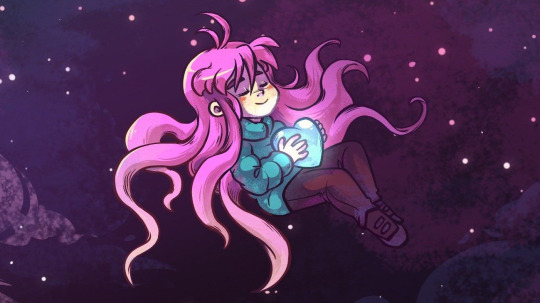
Madeline is your typical platformer protagonist. She can jump and climb walls, but she also has a special ability to dash in all 8 directions, regardless of whether she's in the air or on the ground.
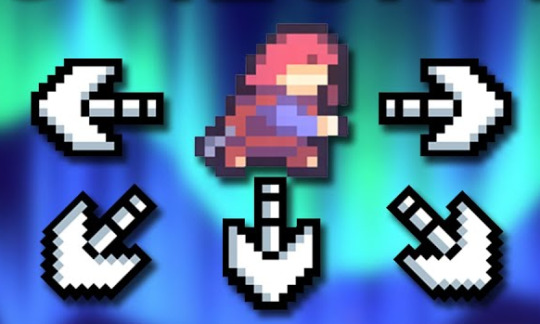
These are your basic movement options and are the foundational building blocks for more advanced techniques. In this particular post we will take an in-depth look at how exactly dashes work, down to the frames.
The Stuff You Learn Normally
Now let's get into the good stuff. Specifically hypers and wavedashes. You learn about these in chapter 8 The Core's C Side and in chapter 9 Farewell.
Hypers
Hypers (also called hyper dashes) are introduced at the beginning of chapter 9's C-Side and are preformed by dashing down-diagonally while on the ground and pressing jump soon after. This technique gives you the vertical momentum of the jump and the horizontal momentum of the dash at the cost of consuming your dash. On top of all that Madeline gets a 1.25x speed boost when she hypers.
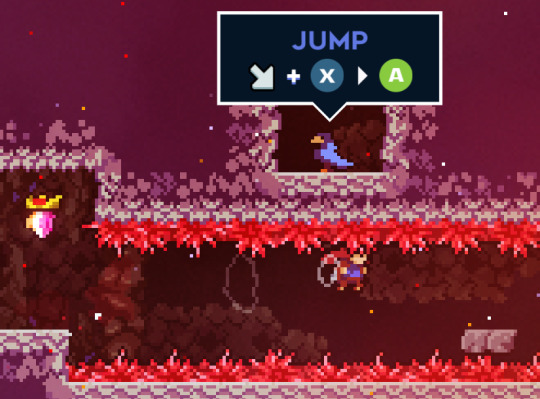
Hypers are super useful for moving horizontal distances quickly and crossing gaps efficiently.
There's also supers (aka super dashes) which are the exact same concept as a hyper (dash + jump) but you instead dash horizontally instead of down-diagonally. This gives you less distance, but earns you more height.
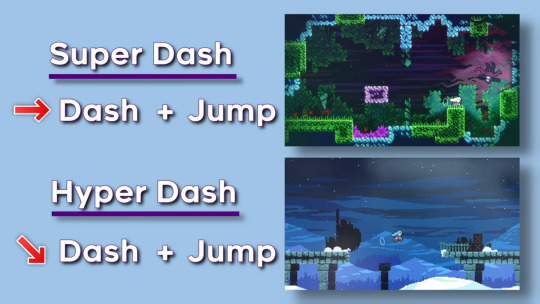
Wavedashes
So remember hypers? You should, you literally just read about them. I'm concerned for you. Well here is a very similar technique. Introducing wavedashes!!!! The game straight up has a pointpoint explaining this so here:
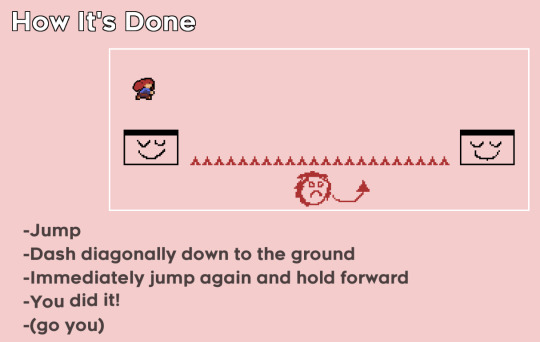
Now you might notice that this very similar to a hyper! It's just done in mid air. Why is that important? Well, it let's you regain your dash. (notice the red hair meaning Madeline can still dash)
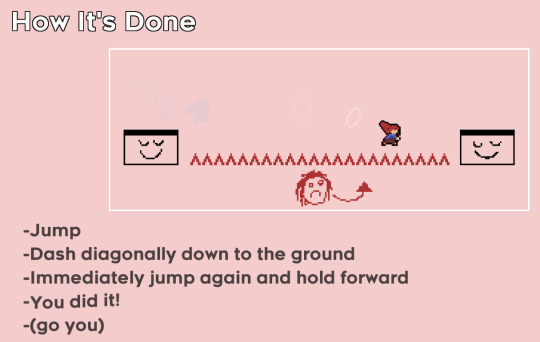
THIS IS A MASSIVE DEAL!!!
This essentially gives you 2 dashes and let's go super fast! Crucial technique for speedrunners.

The game also explains why you can't seem to do it. The actual explanation is more complex than this... but we'll get into that later on...
And that's basically it... or rather it would be... if we played by the rules >:3.
Extending On What We've Learned
Now we are getting into the stuff the game doesn't teach you. We've officially entered the world of dark Celeste speed tech. I promise it's not as intimidating as it seems ;p
So you know how hypers/supers don't give Madeline her dash back? Well... what if they did?
Extending hypers and supers
Back when we learned about wavedashes, I said the reason you got your dash back is because the wavedash is preformed midair while hypers/supers are done on the ground. I lied. That's not the real reason why. To understand what is really happening we need to delve deeper into how Madeline's dash really works.
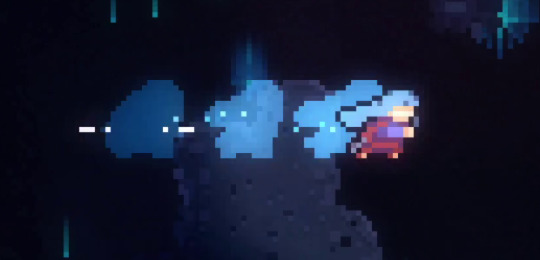
Here's a quote from the developers:
The way it works is pretty straightforward. When you hit the dash button, she flips into a separate ‘dash’ state. A timer is set, her hair turns blue, and she’s given a set velocity in the direction you were holding when you hit the button. The timer then starts counting. For .15 seconds you have no control over Madeline, but then the game gradually gives control back while also decreasing her velocity until you have full control again and her normal state is reinstated. It’s all over in well under a second.
Let's break this down. They mention a timer is set when Madeline dashes. This timer has several functions but the most important one is that it prevents you from regaining your dash if less then 5 frames have passed since it started. 5 frames is about 0.08 seconds since Celeste runs at a constant 60 fps. This is the real reason hypers/supers don't give you your dash back but wavedashes do! We'll comeback to this in a bit.
Next they mention that you don't have control of Madeline for .15 seconds after dashing. This is only half true. You don't have control over her movement, but you can still jump and grab! If you jump mid dash, you perform a hyper/super and Madeline's dash ends immediately. This is also the time period when she's unaffected by gravity. The rest of the information is all correct and unambiguous.
But wait! The only thing preventing us from getting our dash back after a hyper/super is a timer? Can't we just wait it out?
Yes we can!
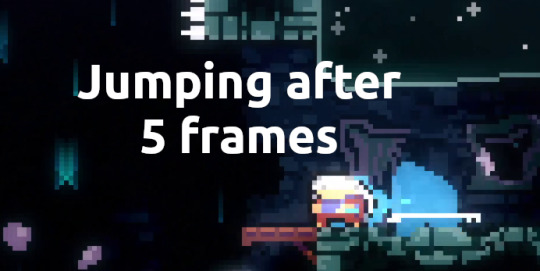
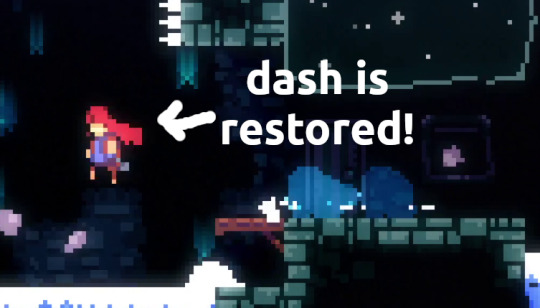
This is called an extended hyper. It's called "extended" because we have to wait out the 5 frame timer before pressing jump. The same concept also applies to supers, in this case called extended supers!
This is, mechanically speaking, the same exact thing as a wavedash!
Some extra notes on extending hypers/supers:
The jump can be performed at any point after the 5 frame timer expires and before the dash ends (a dash ends around when Madeline starts getting affected by gravity again).
You can use coyote time (a small time frame after Madeline leaves the ground when she can still jump) to extend hypers/supers! Just make sure to still be on the ground for the 5 frames!
An extended hyper/super can also be performed by touching the ground mid dash or even in mid air (like a wavedash!)
Extending hypers/supers let's you chain them together. So you can extended hyper into another extended hyper! Just like with wave dashes!
Again wavedashes are just fancy extended hypers!
Also did you notice the pun in this section's title? :3
Phew! That was a lot! Feel free to take a break because we are about the get into the weird stuff!
Bunny Hop Hypers and Cornerboosts
We are in the final stretch don't worry! I know those words sound scary but it's ok. I'll hold your hand so you don't feel afraid :)
Bunny Hop Hypers
So to explain bunny hop hypers we need to learn to bunny hop first. It's a term you probably heard before from other games, but in Celeste it simply means 'jumping as soon as possible and for as short of a time as possible' usually being a 1-frame jump, where you press the jump button then release it on the next frame.
Why is this useful? So, remember how dashes start out really fast and get slower as the dash comes to an end? Well, jumps preserve some of Madeline's horizontal momentum. Letting us keep top-hyper speeds for longer! This is important because normally when you extended hyper you only get hyper speed after you jump. With a bunny hop hyper, you get hyper speed the entire time!
Now let's finally see a bunny hop hyper in action:
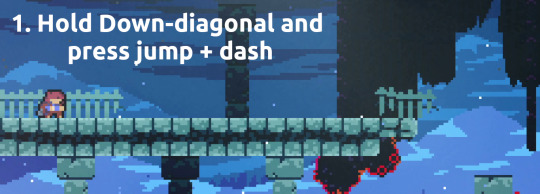
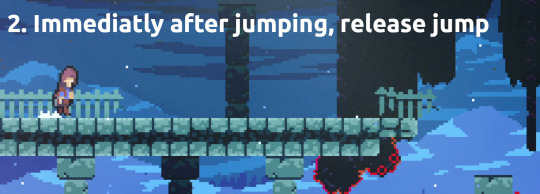
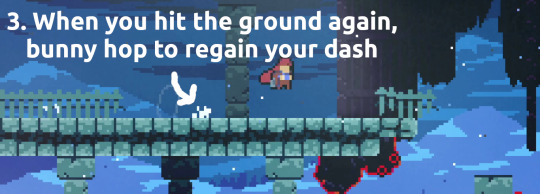

See that wasn't so bad!

All joking aside, if you are having trouble replicating the tricks I discuss, don't worry! This stuff will just get better with practice! A few months ago I couldn't do bunny hop hypers and now I can manage them pretty consistently. It's all about practice and determination!
Before moving on, I wanna say that bunny hop hypers are rare in Celeste speedrunning, at least not as common as extended hypers. They require a lot of specific conditions to be optimal, where as extended hypers can be done just about anywhere! You'll most often see bunny hop hypers in mods rather than normal gameplay.
Now, on to the last trick I wanna show off!
Cornerboosts
This one is a doozy and also the only grab related trick I'll discuss here. Maybe in the future I can talk about overclocking and neutral climb jumps :3
So what's a corner boost? It's a super difficult way to either build up speed or skip entire sections of gameplay of course :D and unlike bunny hop hypers, cornerboosts are used all over speedrunning! So you better get used to them :)
Explaining how exactly they work is difficult and this post is long enough as is, so let's just see how to perform one:
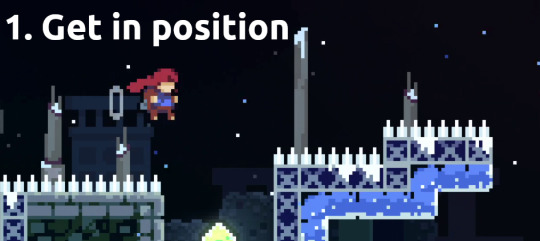

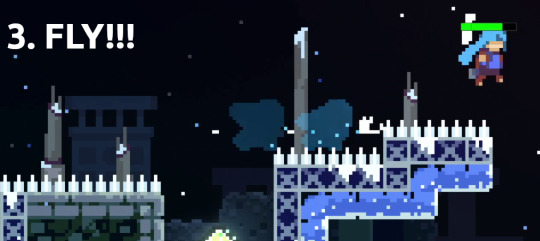
The most important part here is step 1. Madeline needs to be at a very precise position vertically relative to the wall for this trick to work. Try aiming for Madeline's chin to match the top of the wall. Also you might notice the green bar. That's Madeline's stamina (the stuff you consume when climbing). I'm using a mod to demonstrate that doing this trick costs some stamina.
Cornerboosts don't have to be preformed with a horizontal dash, they can also be done with diagonal dashes, but the timing is more strict.
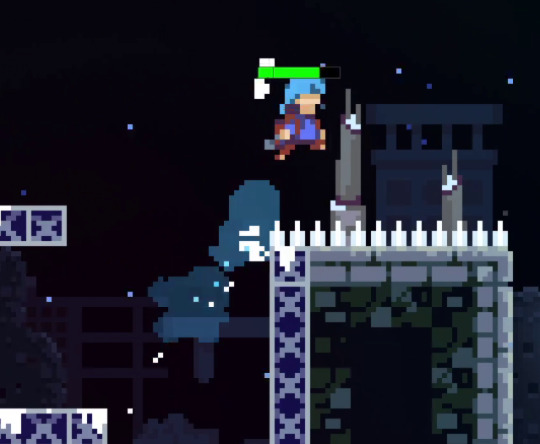
As I said cornerboosts are used all over the speedrun, both to build up a lot of speed in combination with other tech and to skip certain sections. If you wanna see the real power cornerboosts can provide, check out this video of the last checkpoint in chapter 2 and try to count how many cornerboosts are performed. Good luck ;3
Putting All That Into Practice
So. That was a lot. But I have one small challenge for you left. Watch the following clip and try to figure out which strategies where used.
Pause and rewind as many times as needed before reading the next section. Try and play along ok ;p
.
.
.
.
no cheating >:(
.
.
.
.
Did you guess: bunny hop hyper into an up-diagonal dash into a cornerboost? If so then you're a massive nerd and I love you!
By the way, this is the (to my knowledge) fastest strat to clear this room in chapter 1.
Hope you had fun reading all that and that you ended up learning something :) If anything is unclear then just read it again cause I don't make mistakes.
If this gets me the attention I so desperately crave I might do another one of these things! No promises tho ;3
Also have strawb for reading all that <3
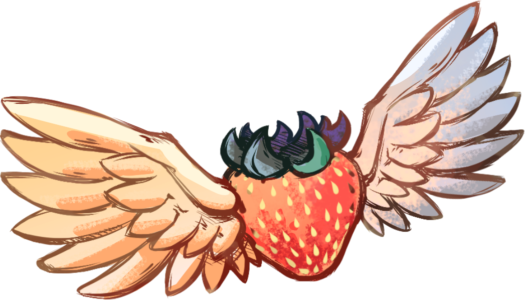
79 notes
·
View notes
Text
Volontés Otome Game English Kickstarter Campaign

Hi everyone! I just wanted to let you all know about an otome game currently available on the Japanese Nintendo Switch eShop that is aiming to get an English localization through Kickstarter.
Here’s a quote from the official campaign:
“This is a localization project for the Nintendo Switch otome game Volontés, which was released in Japan on May 22, 2025. Volontés is a Dark Fantasy × Suspense otome game in which the main character, who has lost everything, finds her way of life while facing tragedy.
Product details can be found on our official site: https://loca.games/volontes/
We need your support to launch the game worldwide. If the campaign is successfully funded, we aim to achieve the following: – English localization for Nintendo Switch – PC (Steam) port as a stretch goal
By supporting us with your pledge, you can get the game at a special discounted price.”
This is an amazing opportunity to support indie game companies in Japan so they can continue creating more otome games. Additionally, the success of English-localized otome games may help convince larger Japanese companies to localize their titles, especially since the otome market in Japan is currently struggling.
Remember, if you want more otome games, you have to support the companies that make them and this is a great way to do just that.
The Kickstarter also includes the game’s story, which I’ll share below:
“It is an era shrouded in darkness, where the world is sealed off, and a deadly plague ravages the land. A peaceful village is ruthlessly attacked by a knightly order, leaving your home destroyed and your family murdered.
Saved by a mysterious figure, you're led to a magical city floating on the sea. There, the stranger proclaims you to be the Moon Witch, destined to guide the people to prosperity. But amidst your newfound safety and status, turmoil begins to brew. A sudden death sends shockwaves through the kingdom, friends turn on each other, alliances falter, and blades begin to clash. You yearn to end the cycle of tragedy and forge a lasting peace.
As tensions escalate, the time will soon come to decide whom to trust and which path to tread to witness the unfolding of your fate.”
I truly hope you’ll consider supporting the Kickstarter. They’ve been very transparent about how the funds will be used, and the page includes a lot of questions, answers, and extra perks for backers. This project could mark a big shift in the localization landscape for otome games. Let's help make it happen!
#otome#japanese#english otome#read otome in english#otome game#anime#manga#otomegame#how to play japanese otome in english#how to play otome games in english#english otome games#how to learn japanese for otome
3 notes
·
View notes
Text
The Ultimate Guide to Lord of the Rings Gifts and Maps
For fans of J.R.R. Tolkien's epic saga, The Lord of the Rings, there’s nothing quite like owning a piece of Middle-earth. Whether you're looking for thoughtful gifts or captivating maps of this mythical world, the possibilities are endless. This guide explores unique Lord of the Rings gifts and the allure of detailed Lord of the Rings maps, perfect for die-hard fans and casual admirers alike.
Why Lord of the Rings Gifts Make Perfect Presents
When considering a gift for a Tolkien fan, themed merchandise has unmatched appeal. Here's why these gifts are so special:
Personal Connection to Middle-earth
Themed gifts allow fans to feel closer to the iconic world of Middle-earth. Whether it’s a replica of the One Ring or a collectible sword, these items evoke cherished memories of the trilogy.
Types of Popular Lord of the Rings Gifts
Jewelry: The One Ring is perhaps the most sought-after gift. Available in various materials, including gold-plated and engraved versions, it’s a timeless keepsake.
Collectibles: From action figures to statues of Gandalf or Frodo, collectibles are a great way to honor iconic characters.
Clothing and Accessories: Hoodies, T-shirts, and scarves adorned with quotes or symbols from the series make stylish and cozy gifts.
Board Games and Puzzles: Immersive board games inspired by Middle-earth adventures are perfect for interactive fun.
Books and Box Sets: Special edition books or box sets of The Hobbit and The Lord of the Rings trilogy remain a classic choice.
Lord of the Rings Maps: A Gateway to Middle-earth
For fans captivated by Tolkien’s intricate world-building, Lord of the Rings maps offer a window into the geography and history of Middle-earth.
The Significance of Maps in Tolkien’s Works
Maps play an integral role in The Lord of the Rings. They provide context for the characters’ journeys, from Frodo’s trek through Mordor to Aragorn’s pursuit of his destiny.
Types of Lord of the Rings Maps
The Original Middle-earth Map: This map, depicting key locations like Rivendell, Mordor, and the Shire, is a favorite among enthusiasts.
The Map of Beleriand: A deeper dive into Tolkien’s universe, this map explores the lands from The Silmarillion, adding layers to the world.
Custom Artistic Maps: Hand-drawn or watercolor versions of Middle-earth maps add a decorative touch to any fan’s collection.
Interactive Digital Maps: Modern digital versions let fans explore Middle-earth interactively, complete with detailed annotations and descriptions.
How to Choose the Perfect Gift or Map
Finding the right Lord of the Rings gift or map requires thought and creativity. Here are some tips:
Consider the Recipient’s Interests
Collectors: Opt for exclusive or limited-edition items, like statues or autographed memorabilia.
Adventurers: Maps or travel-themed items like compasses and journals inspired by Middle-earth are ideal.
Focus on Quality
When choosing a map, ensure it’s well-crafted. Look for high-quality prints or artistically designed pieces that stand out as decorative items.
Practicality vs. Sentimentality
Some fans prefer practical gifts like mugs or T-shirts, while others value deeply sentimental keepsakes, like framed maps or hand-bound journals.
Where to Find Lord of the Rings Gifts and Maps
Online Marketplaces: Platforms like Etsy and Amazon offer a vast selection of handmade and custom-designed gifts.
Official Merchandise Stores: Websites dedicated to Tolkien merchandise provide authentic and licensed products.
Local Bookstores and Gift Shops: Many bookstores stock maps and unique Tolkien-inspired items, making them great places to shop.
Conclusion
The magic of The Lord of the Rings continues to inspire generations, making gifts and maps from Middle-earth more popular than ever. Whether you’re selecting a map that charts the epic journeys of Frodo and Sam or a unique gift to honor a Tolkien enthusiast, the options are boundless. By choosing the perfect Lord of the Rings gift or map, you’re not just offering a present—you’re delivering a piece of the enchanting world of Middle-earth.
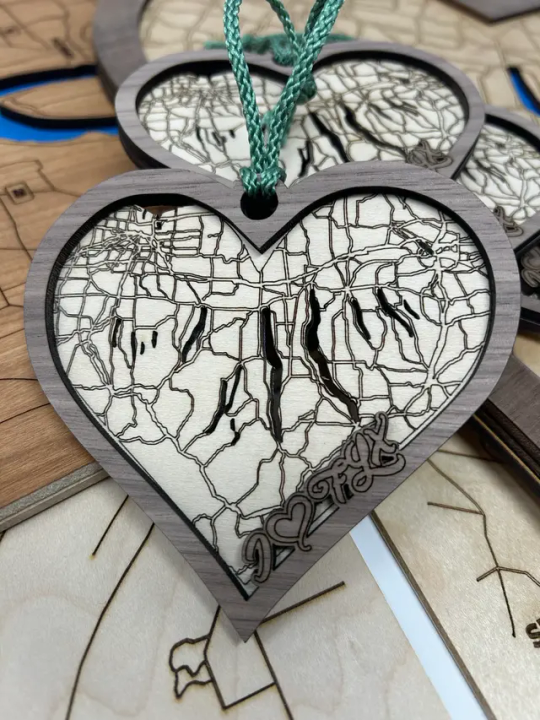
2 notes
·
View notes